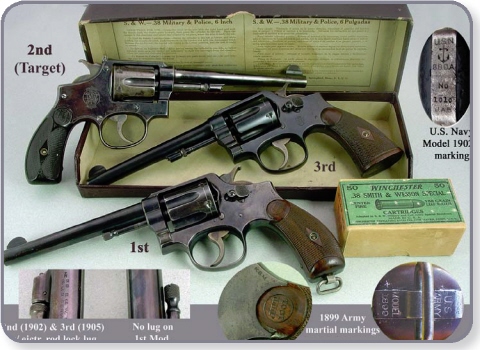
.38 CALIBER
Listed chronologically within frame size.
The .38 Special cartridge could easily lay claim as the most all-around popular and useful revolver round of the 20th century – especially for military, police, and personal protection applications. It was introduced by S&W in 1899, with the full name of .38 S&W Special.
It is important to note that the .38 Special is a completely different round from the earlier .38 S&W round introduced for S&W’s top-breaks back with the Baby Russian of 1876. The .38 S&W is usually a lower-powered loading and has a slightly larger case diameter than the .38 Special. The two cartridges are NOT interchangeable, and ruptured cases or worse can result from trying to fire the wrong cartridge in the wrong gun. Some revolvers that have been supposedly converted from .38 S&W to .38 Special have not been properly converted and may be unsafe to fire. Any such conversion should be inspected by a gunsmith prior to shooting.
Modern high velocity loadings of the .38 Special cartridge have become very popular as effective modern self-defense and police rounds. Some such loadings are designated “+P” (“plus P”) or “+P+” to show that they develop higher pressure than is allowed in standard pressure .38 Special cartridges. It’s important to remember that the original .38 Special cartridge was introduced over 100 years ago – long before such pressure levels were anticipated. Loads rated +P or +P+ should generally not be fired in older revolvers.
COLLECTOR’S TIP
Many .38 Special and .38 S&W revolvers were introduced as descriptively named model Hand Ejectors prior to 1957 and continued as numbered models in the S&W product line after 1957. These will be continued in the next section, and include:
• .38 M&P: See the Model 10.
• .38/200 British Service: 1947; see the Model 11.
• M&P Airweight: 1952; see the Model 12.
• K-38 Target Masterpiece: 1946; see the Model 14.
• K-38 Combat Masterpiece: 1949; see the Model 15.
• .38/44 Heavy Duty: 1946; see the Model 20.
• .38/44 Outdoorsman: 1946; see the Model 23.
• .38/32 Terrier: 1946; see the Model 32.
• .38 Regulation Police: 1946; see the Model 33.
• .38 Chiefs Special: 1950; see the Model 36.
• .38 Chiefs Special Airweight: 1952; see the Model 37.
• Bodyguard Airweight: 1955; see the Model 38.
• Centennial: 1953; see the Model 40.
• Centennial Airweight: 1952; see the Model 42
• Chiefs Special Target: 1955; see the Model 50.
• Target Models: Most .38 Hand Ejectors models were issued with fixed sights. When one of these is found with factory original adjustable target sights it will bring a premium. This will range from 25 to 50% in the lower grades, to triple, quadruple or more in the higher grades.
K FRAME .38
The introduction of the .38 HE Military & Police marks the beginning of what would become the quintessential police handgun of the twentieth century and the workhorse of S&W production for many decades – the K-frame revolver chambered for a .358” diameter bullet. Also especially significant is the introduction of what has probably become the most used centerfire cartridge in America, the .38 Special. The basic design of this gun has been continuously improved over nearly a century, and in its current variations such as the Models 10, 19, and 66, is still considered by many expert authorities to be the finest personal defense or police handgun available.
.38 Military & Police 1st Model (Model of 1899 Army-Navy Revolver)
Caliber: .38 S&W Special or .38 Long Colt (U.S. service cartridge). Double-action revolver built on the round butt K frame with four screws; 6-shot fluted cylinder with a nominal length of 1.56”. Barrel lengths: 4” , 5” , 6” or 6-1/2” round pinned barrels, earliest of the S&W models with a swing-out cylinder in this caliber. No locking lug is present on the barrel bottom of this first model. Service or target sights were available; blue or nickel finish, checkered hard rubber stocks with S&W monograms or plain walnut. Target versions are a square cut round blade front sight on a raised boss with adjustable rear sight. Color case hardened hammer and trigger. This barrel is marked “38 S&W Special CTG & U.S. Service CTG” on the left side. Believe it or not, this gun can be considered a “pre-five-screw four-screw model” since the 5th frame screw was added to the basic Hand Ejector design about 1905. Serial number range 1 - 20975 with 20,975 manufactured c. 1899 – 1902.

Early .38 M&P Models, with distinguishing characteristics and details of early martial markings. ArmsBid.com photo.
ID Key: K-frame .38 M&P lacking locking lug at front of ejector rod.

Variations
• Target model worth two to three times premium.
• U.S. Navy Model: .38 Long Colt with 6” barrel; 1,000 marked “U.S.N.” with an anchor and Navy serial number on the butt without a lanyard ring. Navy serial number range 1 - 1000, S&W serial number range 5001 - 6000, 1900. Worth 50% to 100% premium.
• U.S. Army Model: 38 Long Colt with 6” barrel; 1,000 marked “U.S. ARMY MODEL 1899” on the butt. Army Issue has the inspector’s initials in the grip circles, “KSM” on the right side (for Kelly S. Morse) and “JTT” on the left side (for John T. Thompson) with lanyard ring. S&W serial number range 13001 - 14000, 1901. Worth 50% to 100% premium.
AUCTION BLOCK
Three martial 1899s sold: Army, “90%” - $1,380; Army, “93% plus” -$1,955; Navy, “90% plus” - $1,725 - Amoskeag, Garbrecht collection, Sept. 2005.
PRICE CHECK
1899 Army, “absolute finest example…98%”, listed at $5,500 – David Carroll, 2006.
• Revenue Cutter Service (Coast Guard) Models: See variations listed under next model.
.38 Military & Police 2nd Model
(Model of 1902)
Caliber: .38 S&W Special. Double-action revolver built on the round butt K frame with four screws; 6-shot fluted cylinder with a nominal length of 1.56”. Barrel lengths of 4”, 5”, 6” or 6-1/2” with round pinned barrels. Blue or nickel finish, checkered hard rubber grips or walnut, .265” smooth trigger, .260” checked hammer. Built similar to the First Model and now fitted with a locking lug on the barrel bottom and an increased extractor rod diameter to allow an internal locking rod, with other minor internal changes. Observed with a large S&W monogram on the sideplate while no other markings on the frame are observed. This model also has an additional leaf spring and a spring-loaded ball bearing in the yoke to assist in locking open the cylinder. The barrel markings are “38 S&W Special & U.S. Service CTG” on the left side. Service or target sight variations are found. This model weighs 31 oz. with 6-1/2” barrel. Serial number range 20976 - 33803 with 12,827 manufactured c. 1902 - 1903.

Variations
• Target model worth two to three times premium.
• U.S. Navy Model of 1902: 38 Long Colt, Navy serial number range 1001 - 2000 continued from 1st order in 1900. Marked “U.S.N.” with an anchor on the butt and initials “JAB” for inspector John A. Bell. S&W serial number range is 25001 - 26000 and is found on the front tang. Other markings include an arrow through an “S” found on the cylinder face, on the barrel flat, and in the yoke cut. Caliber markings of “S&W .38 Mil” were also observed on several examples. Worth double to triple standard value.
AUCTION BLOCK
Navy 1902, “92%” - $1,725 – Amoskeag Auction, Sept. 2005.
PRICE CHECK
Navy 1902, “90%”, listed at $1,875 – David Carroll, 2006.
• Revenue Cutter Service (Coast Guard) shipment: Serial numbers range from 20752 – 20801. Shipped to the U.S. Coast Guard Revenue Cutter Service in 1902. Total of 50 guns, worth substantial premium. Although the serial numbers are within the Model 1899 serial number range, it is reported that these are actually Model of 1902 configuration.
.38 Military & Police Model of 1902
– 1st Change
Caliber: .38 S&W Special. Double-action revolver built on the round butt K frame with four screws; 6-shot fluted cylinder with a nominal length of 1.56”. Barrel lengths of 4”, 5” or 6-1/2” with round pinned barrels. Checkered hard rubber grips with S&W monograms, or checkered diamond walnut; blue or nickel finish. Round blade front sight with square notch rear sight. Changes are an enlarged barrel thread diameter and the corresponding change to the frame, as well as changes to the yoke and yoke cut. Barrel marked “38 S&W Special CTG & U.S. Service CTG.” Target models have a rear sight leaf contoured to the frame with an adjustable sight for windage only. The yoke has a small spring-loaded plunger to help hold open the cylinder. Our example serial number 43953 has a small leaf spring for the trigger return and a smooth trigger with a finely checked hammer spur. The first square butt K frames show up in the middle of this model serial number range at about 58,000. Serial number range 33804 - 62449 with 28,645 manufactured c. 1903 - 1904.

Variations
• Target model worth two to three times premium.
.38 Military & Police Model of 1905
(.38 Hand Ejector M&P, 3rd Model)
Caliber: .38 S&W Special. Double-action revolver built on a round or square butt K frame with five screws; 6-shot fluted cylinder with a nominal length of 1.56”, similar to 1902 1st change with round or square butt but with changes in the cylinder stop cut and the frame stop cut. A trigger guard screw is now added, making this the first five-screw model in this series. Serial number range 62450 - 73250 with 10,800 manufactured c. 1905 - 1906.

Variations
• Target model worth premium.
.38 Military & Police Model of 1905
– 1st Change
Caliber: .38 S&W Special. Double-action revolver built on a round or square butt K frame with five screws; 6-shot fluted cylinder with a nominal length of 1.56”. Barrel lengths of 4”, 5”, 6” or 6-1/2” are found as standard. Designed like the previous model with various internal changes; available with blue or nickel finish. Serial number range 73251 - 146899 overlapping with the 1905, 2nd Change model. 73,648 manufactured between 1st and 2nd change c. 1906 - 1909.

Variations
• Target model worth 50 - 100% premium.
.38 Military & Police Model of 1905
– 2nd Change
Caliber: .38 S&W Special. Double-action revolver built on a round or square butt K frame with five screws; identical to 1st Change with minor changes, manufactured with 4”, 5”, 6”or 6-1/2” barrel lengths. Two dowel pins are generally found in the star extractor. Serial number range 73251 - 146899, overlapping with the 1st change of 1905 model. This model was built c. 1906 - 1909.

Variations
• Target model worth 50 - 100% premium.
.38 Military & Police Model of 1905
– 3rd Change
Caliber: .38 S&W Special. Double-action revolver built on a round or square butt K frame with five screws; 6-shot fluted cylinder with a nominal length of 1.56”. Barrel lengths of 4” or 6” are found; available with blue or nickel finish. Minor internal changes were made, including the knurled extractor knob becoming a solid piece. Smooth trigger, .260” checked hammer spur. A large S&W trademark is found on the sideplate. Barrel has patent dates on the right side with “38 S&W Special CTG.” Many examples have been examined with no other frame markings other than the trademark. Serial number range 146900 - 241703 with 94,803 manufactured c. 1909 - 1915.

Variations
• Target model worth 50 - 100% premium.
.38 Military & Police Model of 1905
– 4th Change
Caliber: .38 S&W Special. Double-action revolver built on the K frame with five screws; 6-shot fluted cylinder with a nominal length of 1.56”. Barrel lengths of 2”, 4”, 5” or 6” are found. Round butt or square butt (scarce) frame with service sights or a square butt only frame with target sights, hard rubber or walnut stocks with a diamond around the grip screw escutcheon and gold S&W monograms. Changes from the 1905 3rd Change were primarily internal; heat treated cylinders began at approximately serial number 316648. Fitted with a .265” smooth trigger on the service version or fitted with a serrated trigger on the target version with a .265” checked hammer. Target models are observed without serrated front and rear tangs until about 1923, when they were introduced. Front target sights are a square cut blade on a raised boss while the rear sight is adjustable and is contoured to match the curve of the frame and top strap. Service sights are a round blade front sight, with a notch cut rear in the top strap. Barrel markings observed are “S&W” on the left side and “38 Special CTG” on the right side. Some are found with both markings on the left side with right side blank. Target models have been observed without any frame markings whatsoever (including the S&W trademark normally on the sideplate) except for serial numbers. Otherwise will be marked “Made in U.S.A.” on the frame’s right side. Has the early style hammer block. Weight is 30 oz. with a 6” barrel.
Serial number range 241704 - 1000000 with 758,296 manufactured c. 1915 - 1942.

Variations
• Target model worth premium.
• Square butt frame worth two times value.
• Nickel finish worth premium.
• Texas State Prison: Nickel, 5” barrel, well-used, a small number of handguns purchased 1927 - 1930 scattered between serial numbers 500000 and 630000, marked “Texas State Prison,” worth premium; examples usually show heavy use.
• Original 2" barrel worth premium; 2" round butt +50% to double value; 2" square butt double to triple value. Original nickel on these will bring a further premium.
AUCTION BLOCK
2” round butt .38 HE 1905 4th, “as new in box” - $1,540 - Supica’s Old Town Station, Oct. 2003.
PRICE CHECK
2” .38 HE 1905 4th, UPD marked (possibly Utica Police Dept.), “95%” – Lyle Larkworthy, GunsAmerica.com, 2006.
• USNCPC marked: 3,000 handguns total in the 748000 - 760000 serial number range; U.S. Naval Civilian Police Corps abbreviation on the backstrap, worth double to triple standard values. Most shipped in 1941.
• USMC: In 1932, 1000 handguns shipped to the U.S. Marine Corps, 6” barrel with blue finish on square butt frame in a very broad serial number range, markings not reported. Worth premium.
• Other “U.S.” marked: 4", 5" and 6" handguns were bought by the Army in 1941 - 1942. Often marked “U.S.” on the left side of the frame or on the butt. Worth 50 - 100% premium.
• 25 M&P revolvers with 4" barrels, blue finish, square butt, purchased by the Coast Guard in 1934. Serial range of 646994 - 648882.
• 50 shipped to the U.S. Army A.E.F. shooting team in 1920 with 6" barrels. Two with target sights.
• 36 M&P revolvers shipped to U.S. Secret Service in 1935 in the 651500 serial number area.
• Small quantity shipped with chrome finish.
• Small quantity shipped to Newport News, Va., Police Dept. 6" barrel blue finish, fixed sights with serrated backstrap and frontstrap. One example is marked “Pol. Dept. Newport News, Va. No. 5” on the sideplate. This variation has the small S&W trademark on the frame, without S&W medallions in the wood grips. (Our example was serial number 583499.)
• Serial number 642357 attributed to Herman Goering c. 1934 and was turned over to Allied soldiers at his surrender on May 7, 1945, and currently is at the West Point Military Academy.
.38/200 British Service Revolver
(Model K-200)
Caliber: .38 S&W with 200-grain bullet. Double-action revolver built on the square butt K frame with five screws. Available with 4”, 5” or 6” pinned barrel lengths; 6-shot fluted cylinder with a nominal length of 1.56”. Available in bright blue, sandblast brush blue, or sandblast black magic finish. 1/10” round blade front sight and notch cut rear service sights; square butt frame with checkered diamond walnut grips with S&W monograms for the commercial version, smooth walnut without monograms with lanyard ring for the military service version. It is reported that 110,379 K-200s were sold to the British with Black Magic finishes, using both the carbonia and Black Magic processes, beginning at around serial number 680,000. The serial range continues within the M&P series 1905 4th Change, in a range of c. 700,000 - 1,000,000. Then the revolver was numbered with a “V” serial prefix (for Victory) in the same serial number range as the .38 Special Victory Models starting over from V-1 – c. V-769,000. Early Lend Lease guns were marked “UNITED STATES PROPERTY” or “U.S. Property” on the top strap. “Made in U.S.A.” appears on the right side of the frame in front of the trigger guard with the S&W trademark on the sideplate, usually with “G.H.D.” or “W.B.” inspector marks. Later production guns were marked the same as the Victory Model. When a new style hammer block was introduced in Dec. 1944 (due to an accidental discharge aboard a Navy ship when a gun was dropped, killing a sailor), the serial prefix was again changed, this time to “SV” to indicate this new change hammer block. This serial number range runs from c. SV769,001 – c. SV811,119 and is numbered concurrently with the Victory Model chambered in .38 S&W Special. It is reported that a “VS” serial prefix exists but the authors have never confirmed this (possibly on low-numbered guns where there is room to stamp an “S” ahead of the “V”). 568,204 guns were reported manufactured c. 1940 – 1945.

PRICE CHECK
RAF marked 38/200 British, “97-98%”, listed at $1,275 – David Carroll, 2006.
Variations
• Recent import markings reduce value.
• Non-factory converted to .38 Special: Will detract from the value, and should be checked out by a competent gunsmith, as some of these conversions are poorly and unsafely done. Note that the .38 Special cartridge is slightly smaller in diameter than the .38 S&W (38-200), and a .38 Special will usually crack or bulge the case if the conversion was not properly done. Many were done by Parker-Hale in England.
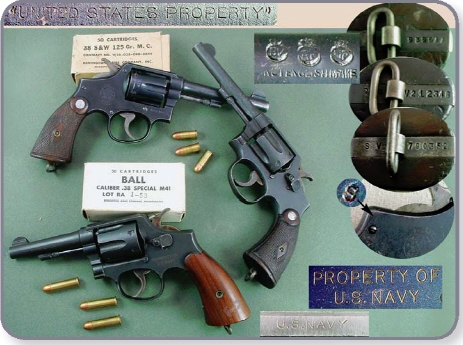
British .38/200 (top two guns) and Victory Model (bottom) revolvers. Although some refer to the .38 S&W chambered British Model as a “Victory Model,” that term is more properly applied to the .38 Special version. Inset details include “United States Property” and post-war British civilian proof marks; variations in serial number markings (no prefix, “V” prefix, “SV” prefix, and “S” on frame); and U.S. Navy markings. Old Town Station photo.
• Reported that the last revolver in this series was delivered to British Ambassador Lord Inverchapel, 4/16/1947, serial number 0775885, high polish carbonia blue, 5" barrel.
Production Changes
Note: Post-war changes follow those of the .38 M&P, pages 143-144. With the introduction of the short-action, they may be called the "Pre-Model 11."
• 1946: Begin ‘S” serial prefix.
• 1948: Begin “C” serial prefix.
• 1955: Delete upper sideplate screw.
• 1957: Continued as the Model 11 (see next section).
COLLECTOR’S TIP
Military Finish: In previous editions, we had described a type of finish used on .38/200 British and Victory Models as “parkerizing.” Our current understanding is that parkerizing was a proprietary phosphate type finish used on many military guns, many of which were given a less cosmetically fine finish as a result of wartime expediency (with the added benefit of reducing tell-tale reflective glare from military weapons). Other than possibly for a very brief period of as few as five days in May of 1942, the parkerizing process was not officially used by that name on S&W revolvers, although the appearance is very similar in late war production guns.
The S&W revolvers very generally had the bright commercial blue through about 1941, a brief period of sandblast blue (or “brush blue”) beginning March 3, 1942, followed by sandblast “Black Magic” (similar to parkerizing) through the war’s end. The Black Magic and other parkerized type finishes tend to be rather fragile and thin, so finish coverage appears to deteriorate more rapidly, even with only minor handling, than with commercial blue finishes. This results in fewer “As New” or 100% finish guns in circulation. Also note that military weapons are routinely subject to arsenal rework and refinish. Such arsenal refinished pieces certainly are legitimate historical variations, but will generally bring less from a collector than original factory finish. Detecting such refinish may be difficult.
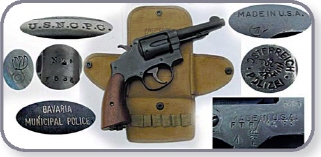
Victory Model, with markings observed on Victory Models and the similar British 38/200 Models. Clockwise from top left: Naval Civilian Police Corps; Canadian military broad arrow inside C (with “Made in U.S.A.”); Austrian Police; typical British military markings (including broad arrow); Bavarian Municipal Police; U.S. flaming ordnance bomb; and New Zealand backstrap marking. ArmsBid.com photo.
.38 Military & Police “Victory” Model
Caliber: .38 S&W Special. Double-action revolver built on the square butt K frame with five screws, so named for the “V” placed in the serial prefix for “Victory” against the Axis powers in WWII. Normally found with a 4” round pinned barrel, (2” scarce); 6-shot fluted cylinder with a nominal length of 1.56”. Lanyard ring usually found on the butt; sandblast blue or sandblast Black Magic finish (similar to parkerizing), non-shrouded extractor, 1/10” forged round blade front sight with square notch rear sight. Smooth wood grips without S&W medallions on a square butt frame, introduced with a “V” serial prefix from V1 to V769,000, at which time a new design hammer block was introduced and the serial prefix became an “SV” added to indicate this change.
It is reported that a “VS” serial prefix exists but the authors have never confirmed this. An accident with this model forced an important step for S&W concerning hammer blocks. A revolver was dropped on the deck of a U.S. Navy ship and accidentally discharged, killing a sailor. This prompted the Navy to investigate and request, through the Springfield Armory, a better hammer block design. The former hammer safety was a shoulder on the rebound slide forced against a shoulder on the hammer. These “shoulders” kept the hammer nose off the cartridge in the down position. Enough force would shear the hammer pivot and the hammer nose would strike the primer, discharging the cartridge. A new design was introduced in Sept. 1944, known as the “slide action hammer block,” which placed a sliding arm between the hammer face and the frame unless the hammer was properly pulled to the rear. Approximately 40,000 revolvers were sent back to S&W for modification with this new design hammer block. This required slight modification of the hammer rebound slide and a groove cut into the side plate to accommodate the safety slide. Revolvers returned and modified are found with a small “s” near the rear sideplate screw, as well as a “S” found on the butt along side the serial number. This new design hammer block is still continued today in all S&W revolvers. Markings consist of “U.S. Property” stamped on the topstrap with a “GHD” inspector’s stamp indicating Guy H. Drewry (inspector from 1930 - 1957) elsewhere on the frame. The “G.H.D.” stamping usually occurs in a serial range of V85000 to very close to the end of production. Serial numbers range from V1 - V769000 and SV769001 - SV811832 (as the highest recorded number to date on a nickel variation for a commercial order), numbered concurrently with the 38/200 British Service Model. About 242,291 were manufactured c. 1942 - 1945.

Variations
• 2" barrel scarce, worth 4 - 5 times premium if lettered from the factory. It is known that 300 with 2" barrels went to the Dept. of Justice.
• A very few reported with Israeli markings, worth premium.
• “U.S. NAVY” Marked: Worth premium – add 50 - 100% if marked on topstrap; double to triple value if marked “PROPERTY OF U.S. NAVY” below thumb release. Beware of fake markings.
• Many interesting variations and markings found: USMC, Bavarian Rural Police, Australia, New Zealand, South Africa, etc. Check for counterfeit markings as many are in circulation.
• Unmarked: Many were sold to civilian users (Defense plants, Post Office, etc.) and do not have U.S. or inspector markings.
• A small quantity of approx 86 “Victory Models” were made in the last of the “SV” serial range with a nickel finish but having the lanyard ring removed and the hole plugged. These occurred at what appears to be the end of production of the Victory series and were to fill a commercial order. Blued commercial variations are also found without the lanyard ring and the hole also plugged.
• One correspondent reports Victory Models still in active government service as late as the 1980s, when they were reportedly issued to National Park Service Rangers in California.
• At the time the “V” was first used as a serial number prefix, a small number of revolvers were reportedly special finished with polish, bright carbonia blue, and select figured smooth walnut stocks for special presentation purposes; serial numbers 1000000 and V1 - V5. V1 went to Chief of Wartime Production Lt. Gen. Wm. Knudsen, and was later presented to President Harry Truman.
The authors highly recommend for further research and reading a volume titled U.S. Handguns of World War II, The secondary Pistols & Revolvers by Charles W. Pate, printed in 1998 by Andrew Mowbray publishing, Lincoln, RI. This is an excellent book that contains extensive research on the Victory Models.
Some additional Victory Model tips from Eric H. Archer:
Late Production Victory Revolvers assembled with the new style hammer safety block are of special interest. The butts were marked with an S V on one side of the lanyard swivel. A small letter “S” on the sideplate denotes factory fitting of the new safety block. These newest and safest Victory revolvers were most likely to have been used in later conflicts in Korea, Vietnam and Desert Storm.
Postwar Commercial Victory Revolvers were assembled using frames and other components leftover from wartime production, but not purchased as spare parts by the U.S. government. Characteristics include “SV” prefix, serial in the 800000 range, a factory fitted plug in the hole where the lanyard loop swivel would otherwise be found, a brushed blue finish, and commercial diamond magna grips similar to prewar production. Careful examination of frames usually reveals surface irregularites due to minor forging flaws or hurried removal of excess metal, acceptable while there was a war going on. Contemporary Smith & Wesson ads highlighted upcoming release of these revolvers to meet unfilled orders for law enforcement. Oshmans Sporting Goods in Houston received many of thsee commercial Victory revolvers.
Preferential issue of revolvers to aviators and military dog handlers continued for decades after World War II. Regulations prohibited carry of M1911 and M1911A1 pistols with a loaded round in the chamber, but you can’t drop your dog’s leash or fly a helicopter hands-free while you cycle the slide to load a .45. Victory revolvers remained in use by Army aviators until second-generation double-action mm pistols became available for aircrew use. Thereafter, some of the finest Victory revolvers remaining at the Army helicopter school at Fort Rucker were transferred to the Naval Historical Center.
United States Air Force Air National Guard tanker and transport crews were issued Victory revolvers during Desert Storm. Unfortunately, there is no way to differentiate USAF Victory revolvers from those used by the other armed services.
Pantograph Engraved Markings on Victory revolvers should always be viewed with suspicion. Skepticism is particularly appropriate when the revolver has been reparkerized, or where the markings are not documented in SCSW or Charlie Pate’s book. To cite one example, many 4” .38 Special revolvers reportedly imported from Taiwan in the 1980s were pantographed engraved with the letters “U S” above “M C” at the rear of the frame above the backstrap. Firearms engraved with the name of a Coast Guard cutter, or marked to imply association with the FBI or the CIA or any of its proprietaries such as Air America, are almost certainly evidence of fraud.
Crude etched markings have been observed on Victory revolvers used by miscellaneous governmental agencies such as the National Park Service and Indian tribal police. These markings are often authentic, but unlikely to increase collector value.
Victory Officer’s Model was the term applied in United States Marine Corps ordnance publications to postwar long-action Military & Police revolvers with 4” barrels, lanyard loops, magna grips, and commercial blue finish. Backstrap is roll-marked “U.S. PROPERTY.”
.38 Military & Police (Postwar)
– “Pre-Model 10”
Caliber: .38 S&W Special. Double-action revolver built on the square butt K frame with five screws. A continuation of the previous model without the “V” serial prefix or the lanyard ring. A contemporary source indicates the “S” prefix postwar guns began as early as Dec. 27, 1944 at around serial number S769000. Others report Sept. 1945 beginning at S811120. It’s reported that at S990184, Apr. 7, 1948, the new short throw hammer action was introduced, becoming the now familiar Model 10 in 1957. Many postwar frames will have the hole in the side of the frame for the access to the lanyard ring lock pin. Postwar production frames will also have the four address lines of “Made In U.S.A., Marcus Registradas, Smith & Wesson Springfield, Mass.” on the right side.
After the production of the second million M&P revolvers, the serial prefix was again changed to a “C” prefix on March 22, 1948, starting over at C1, and was also numbered concurrently with the M&P Airweight and the M&P .22 or pre-Model 45. The “C” prefix continued until 1967 when a “D” serial prefix was introduced after C999999. Available in 2”, 4”, 5” or 6” round pinned barrel lengths with a 1/10” fixed round blade front sight and a square notch rear sight (later changed to 1/8”). Available in blue or nickel finish. The 6-shot fluted cylinder has a nominal length of 1.56”. Case colored .240” serrated trigger with finely checked hammer with .265” spur, checkered diamond walnut grips with S&W monograms, S&W trademark on the sideplate. Barrel markings are “Smith & Wesson” on the left side and “.38 S&W Special CTG.” on the right side. Smooth backstrap and forestrap. Serial numbers are found on the butt, cylinder face, barrel flat, yoke face (viewed through a charge hole), the rear of the star extractor, and on the right grip panel. The round butt frame variation became available in late 1947. The 2” variation will have “Smith & Wesson” and the caliber marking on the left side of the barrel. Weight is 29.5 oz for the 4” version. Became the Model 10 in 1957. Manufactured c. 1946 - date.

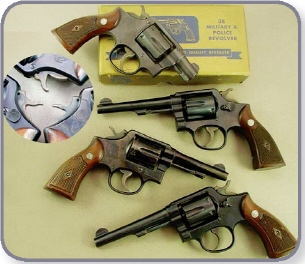
Pre-Model 10s. Top two “S” prefix, bottom two “C” prefix. Note variations in hammer spur configuration. ArmsBid. com photo.
Production Changes
• 1945: Begin “S” serial prefix at S811120 - S999999.
• 1948: Begin “C” serial prefix at C1 - C999999.
• 1952: Change front sight from round blade to ramp.
• 1955: Delete the upper sideplate screw.
• 1957: Continued as the Model 10 – see next section.
Variation
• 1946 (Mexican) Target: 2901 units shipped in 1945 and 1946 in serial number range 812000 – 817000.
• 25% premium for “S” serial number prefix in higher condition grades.
• Add 25% for 2" barrels.
Transitional Models
See discussion of Transitional Model concept in general at the beginning of the .38 N frame section. A similar transition process can be observed in post-war .38 M&P’s, beginning with the first “S” prefix commercial gun with the new hammer block at about S769000 on 12/27/1944. The same source offers two conflicting dates on the introduction of the short action, noting the first “K38” short action and new hammer at serial number S924878 on 10/21/47; but also noting the “1st M&P” short action as serial number S990184 on 11/13/50. There is probably a premium for such transitional models.
The K-38 Target Masterpiece
– “Pre-Model 14”
Caliber: .38 S&W Special. Double-action revolver built on the square butt K target frame with five screws, this original postwar model has a 6” barrel with a narrow rib; 1/8” or 1/10” Patridge front sight with the new micrometer click rear sight. Blue finish. The narrow ribbed barrel has markings of “38 S&W Special CTG” on the right side, “Smith & Wesson” on the left. 6-shot fluted cylinder with a nominal length of 1.56”, anti-backlash trigger with adjustable stop, short cocking action, .375” short throw hammer, checked Magna style diamond walnut grips with S&W monograms, K serial prefix. A large S&W monogram is stamped on the sideplate; 6-groove serrated backstrap and forestrap. Companion gun to the K-32 and K-17. Became the Model 14 in 1957. Weight: 38.5 oz. Introduced at serial K1661. Manufactured c. 1946 – 1982.

Variations
• Police Guns: Kansas City, Kansas, Police Department purchase of 4” Masterpieces and Illinois State Police purchase of 5” Masterpieces, both in 1957, are reported in the SWCA Journal, with serial numbers listed. Not specified whether model marked. KCPD information is in 25th Anniversary Book 1, pg. 265; ISP information is in Book 2 on pp. 342 and 366. Either may bring two to three times standard value.
• Premium for nickel finish.
• Army purchase may bring double standard value.
Production Changes
• 1947: Begin production at serial K1661.
• 1949: Manufacture heavy barrel to match K-17 and K-32 in weight.
• 1951: Target grips available.
• 1952: Delete 1/10” Patridge front sight from catalog.
• 1955: Delete upper sideplate screw.
• 1957: Continued as The Model 14 – see next section.
Note: The major distinction between the K-38 Target Masterpiece and the K-38 Combat Masterpiece is the barrel length and front sight.
The K-38 Combat Masterpiece
– “Pre-Model 15”
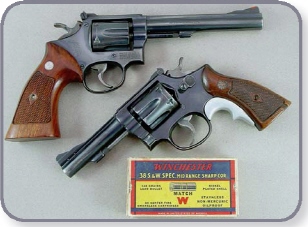
K-38 Masterpiece (top) & K-38 Combat Masterpiece. ArmsBid.com photo.
Caliber: .38 S&W Special. Double-action revolver built on the square butt K Target frame with five screws; 6-shot fluted cylinder with a nominal length of 1.56”; 4” pinned and ribbed barrel with markings of “38 S&W Special CTG” on the right side, available in blue or nickel finish, .375” or .500” target hammer, 1/8” Baughman Quick Draw on plain ramp base front sight with micrometer click adjustable rear sight. Square butt frame with diamond walnut grips. A large S&W monogram is found on the sideplate; 6-groove serrated backstrap and forestrap. Original K serial prefix. Manufactured c. 1949 - 1999.

Variations
• See variations listed at K-38 Masterpiece above.
Production Changes
• 1955: Delete upper sideplate screw.
• 1957: K-38 Combat Masterpiece continued as the Model 15 – see next section.
.38 Military And Police Airweight
– “Pre-Model 12”
Caliber: .38 S&W Special. Double-action revolver built on the round or square butt K aluminum alloy service frame with five screws; similar to the Model 10 but made with an alloy frame and originally an alloy cylinder, which was later changed to steel due to problems with cylinders cracking. Built on the KA frame with short action, with a 6-shot fluted cylinder with a nominal length of 1.62”. Offered in blue or nickel finish, with a 1/10” serrated ramp front sight with square notch rear fixed sight; 2”, 4”, 5” or 6” pinned barrels were catalogued but the 5” and 6” variations were possibly not in actual production as they are not found. Round or square butt frame with checkered walnut Magna style grips with diamond around the screw escutcheon and S&W medallions. Original five-screw frame and flat latch thumbpiece, .240” hammer and trigger that is narrower than the regular production K frame hammer and trigger, which is .258”. Numbered with the Model 10, 11, 45 and Aircrewman revolvers in production. This alloy frame is slightly thinner than a standard K frame by .080”. Has a smooth backstrap and forestrap. With all alloy frame and cylinder and 2” barrel weight is 14.5 oz. Produced c. 1952 - 1986.

Variations
• Slight premium for nickel.
• Slight premium for early square butt frame.
• Slight premium for early guns with bug screw.
• Serial X124 is a 3" square butt frame with a wide hammer for test and evaluation, steel cylinder, five-screw frame, “Airweight” marked serrated ramp front sight. Shipped to Evaluators Limited 4/23/53.
Airweight Production Changes
• 1952: Introduction at A218567 (early prototype; standard production began around C223999).
• 1954: Alloy cylinder changed to steel due to cracking.
• 1955: Delete upper sideplate screw.
• 1957: Continued as the Model 12 – see next section.
Variations
• Early production with alloy cylinder worth premium, but should not be fired.•
A SHORT BACKGROUND OF AIRCREWMAN REVOLVERS
.38 Military & Police M13
Aircrewman Revolver
As a result of new conflicts and the lessons learned from World War II, many new armaments and test weapons were produced by the various armories and arms factories. One such weapon was the Air Force “Aircrewman” revolver built by Colt and Smith & Wesson.
Both companies supplied samples of .38 Special caliber revolvers with alloy frames and cylinders with 2” and 3” barrels: the Colt’s “Detective Special” and the Smith and Wesson “Chiefs Special.” Smith and Wesson later also supplied a 6-shot version of the .38 Military & Police model with an alloy frame and cylinder to be known in 1957 as the Model 12.
After considerable testing and evaluation, the War Department chose to purchase a quantity from both Colt and Smith and Wesson for further evaluation in the field.
The Colt revolvers were specially marked with a serial number range of “A.F.NO. 1” to “A.F.NO. 1189.” This was Colt’s first and only production lot purchased.
Smith and Wesson’s first production lot was a quantity of 605 6-shot revolvers serial-numbered in sequence after the Colt lot from “A.F.NO. 1190” to “A.F.NO. 1794.” This was followed with a second lot of 5-shot J-frame revolvers, serial “A.F.NO. 1795” through “A.F.NO. 2399,” also a quantity of 605. Four examples of each frame size out of the numerical sequence went to the Springfield Armory, for a total of 609 each in J and K frame size.
The distinguishing marks of both of these early Smith &Wesson 5-shot and 6-shot revolvers are as follows:
1) “AIRCREWMAN” stamped on the barrel’s right side with “.38 SPECIAL CTG.” stamped underneath. “SMITH & WESSON” is stamped on the barrel’s left side.
2) “PROPERTY OF U.S. AIR FORCE” marked on the smooth backstrap.
3) Air Force Medallions in the grip circles on a round butt; diamond checked walnut grip.
4) A small “P” proof mark is found over the trigger guard on the left side of the frame.
5) An “A.F.NO.xxxx” serial number prefix found on the butt.
These early 6-shot K-frame Aircrewman revolvers have a five-screw frame with a small removable bushing in the center of the recoil shield. This bolster bushing was a bearing surface for the bolt and extractor rod to ride on. The 5 shot Aircrewman (J-frame) revolvers had a four-screw frame and a smaller removable bolster bushing. A five-screw J frame has been observed as a prototype for the Air Force contract. Examination of these early Aircrewman J and K frames shows that the frame, cylinder, yoke and barrel had matching serial numbers (without the “A.F.NO.” prefix).
The grips were the standard checked diamond walnut grips of the period except for the Air Force medallions in the grip circles. These Air Force Medallions are only found on the A.F.NO. numbered guns. (Colt had a medallion that looked similar to an Air Force coat button.)
The early 6-shot Aircrewman revolvers were in every way identical to the then-current commercial production M&P Airweight except for distinguishing markings. The M&P Airweight was introduced to the product line at approximately serial number C223,999 of the then current M&P numbering system in Sept. 1952. They were numbered concurrently along with the pre-Models 10, 11 and 45 in a serial number sequence that went to C999,999 (and then started over with a “D” serial prefix in 1967).
After the first production lot of 605, no additional J-frame revolvers were purchased. The Air Force preferred a 6-shot revolver and the Army had no other requirements for the smaller revolver. Upon further testing the lightweight 6-shot M&P, the Army felt that the cylinder lock bushing on the recoil plate was not needed (Colt never used the bushing). The Army also believed that removal of the upper side plate screw (also not used on Colts) would provide a better appearance and fewer components and so requested Smith & Wesson to delete the “fifth” screw and the bolster bushing. This request was made in March 1953. The authors do not as yet know why, but only Smith & Wesson was awarded production contracts for the Aircrewman Revolvers. The “M13” is a military designator as is assigned to each standard weapon in the U.S. Arsenal.
Archive documents indicate that the Colts and perhaps the early Smith & Wessons may have been marked with an “M12” designator, but samples in the Springfield Armory do not indicate this and none of the Smith and Wessons there are so marked.
The M13s followed in serial sequence a large lot of Military & Police Airweights that factory records indicate were shipped to various dealers and hardware stores in the country. The authors believe all of the commercial M&P Model 12 Airweights are five-screw frames with the recoil plate bolster bushing, and “Airweight” marked on the barrel’s right side. Other than the military markings and the barrel markings, a four-screw frame with no bolster bushing in the recoil plate is the most obvious difference between an M&P Airweight and an M13 Aircrewman. As alloy will usually break before it bends, reports of using higher pressure cartridges resulted in frequent failure of the cylinder.
Both the S&W and the Colt revolvers were tested for use with the M41 ball cartridge ammunition, which had a standard chamber pressure of 16,000 psi. It is interesting to note that the alloy cylinder was widely reported to have been replaced with steel in 1954, but inspection of over 300 guns over a very wide serial range shows alloy cylinders matched to the frames on all but one. The authors have found only one replacement cylinder in steel.
In 1956 the Army printed a Technical Manual for the Colt and Smith and Wesson revolver as a joint services publication. The manual’s nomenclature is “TM 9-2027” dated July 1956; it is 60 pages in length.
The holster used with this revolver is also a collector’s item. It is stamped “55D3513” and is intended to hold a 2” revolver worn with a shoulder strap or around the waist.
It is known that the government chose to destroy most of the alloy revolvers in excess of their requirements. In letters received dated Sept. 21, 1959 (R&M letter 59-60 and 65) the U.S. Air Force issued a directive to consider all aluminum S&W and Colt revolvers as unsafe and to be mutilated to prevent further use as a weapon! Most destroyed handguns were either crushed, torched or saw-cut and sold as scrap metal.
Many thanks to Charles Pate for his assistance in researching Aircrewman revolvers.
Production Variations
• J-frame “Baby Aircrewman,” 5-shot, one production run of 609, with “A.F.NO.xxx” serial prefix, four-screw frame (also see Pre-Model 37).
• K frame 6-shot with serial prefix of “A.F.NO.xxx”; 609 units; five-screw frame with removable bolster bushing.
• K frame with “C” serial prefix – same mechanical frame as above with change in roll markings and barrel markings. Space in the words “Light Weight” and “M 13.”
• K frame with “C” serial prefix with a four-screw frame and bolster bushing removed. No spaces in roll markings except for an early small quantity.
• K frame with “C” serial prefix with small change in shape of the original flat latch to 2nd variation of thumbpiece.
• K frame with “C” serial prefix; deleted serial number stamping on the yoke and barrel flat; some serial numbers still found on the cylinder.
• K frame with “C” serial prefix; move barrel markings (interchanged from left and right side with an addition of “*” on the barrel).
• K frame with “C” serial prefix with a more ramped flat latch or 3rd variation thumbpiece.
• K frame with “C” serial prefix with no backstrap markings or only stamped “U.S.”; scarce, worth premium.
• Steel cylinders are not known in military sales but are found as replacement cylinders from S&W.
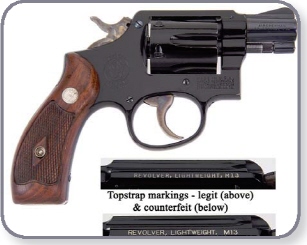
Aircrewman. Nahas collection, from Paul Goodwin photos.
USAF M13 (The Aircrewman)
Caliber: .38 Special. Double-action revolver originally built on the round butt alloy K frame with five screw. About .080” thinner than a standard K frame of that era, with an alloy 6-shot cylinder having a nominal length of 1.62”, blue anodized finish, 2” pinned barrel, .240” checked hammer with .240” serrated trigger. Diamond insert walnut grips, 1/10” serrated ramp front sight with square notch rear. A flat latch thumbpiece with the three variations has been found on many models, similar to the Model 12; has “Revolver, Lightweight, M-13” stamped on the topstrap and “Property of U.S. Air Force” stamped on the backstrap. Most were destroyed by the government. Has a “C” serial prefix in a range of C247000 - C405363. Numbered concurrently with Model 10, 11, 12, and 45.
A production run of 605 early versions were serial-numbered with an A.F.NO prefix (A.F.NO.1190 - A.F.NO.1794) These are a five-screw variation with “Aircrewman” on the barrel, but with no topstrap markings. Air Force medallions in the grip circles with a smooth backstrap. A “P” inspector’s stamp is found on the left side of the frame above the trigger guard. These early Genuine Aircrewmans have all matching serial numbers on the frame, cylinder face, grips, and barrel. Many were repaired by military armorers, who interchanged parts, especially cylinders, with non-matching numbers. Weight 14.5 oz. Approximately 40,000 manufactured (but most destroyed) c. 1951 – 1957.
COLLECTOR’S TIPS
• Counterfeit and reworked Aircrewmans are commonplace. See above text.
• Unlike the Model 12, few original examples with steel cylinders are known to exist.
PRICE CHECK
• A pair of crushed M13 Aircrewmans was listed for sale for $125 for both (by one of the authors). After lingering unpurchased for many months, they were finally sold at a further reduced price (to the other author). On close inspection the buyer discovered that one was held together by rubber cement. No refund was offered. There’s no real point to the story, other than as an instructive tale as to the depths to which this S&W addiction can sink.

AUCTION BLOCK
M13, “97%” - $2,300 – Amoskeag Auction, Sept. 2005.
Another, “traces” - $489 – same auction.
Variations
• Guns with an “AF” prefix may bring four times to five times standard value and typically bring $4500 - $5400.
• Nine production variations known.
• Correct guns that are unmarked or have “U.S.” only on backstrap may bring double standard value.
I FRAME .38
The .38 Regulation Police and the .38/32 Terrier are five-shot revolvers chambered for the .38 S&W round, which is shorter, older and less powerful than the .38 Special round. The .38/32 model designation refers to a .38-caliber chambering on a frame designed for .32 caliber. The I frame was too small for the .38 Special round and was eventually discontinued and replaced by the J frame, which would accommodate both 5-shot .38 Special and 6-shot .32 configurations. Also note that the average .38 Special cartridge will not fit within the frame opening of an I frame or the Improved I frame, which has a nominal frame opening of 1.52” X 1.33”. All examined I frames and improved I frames have a nominal cylinder length of 1.25”, thereby requiring the new J frame with a larger frame opening to fire the .38 Special cartridge. This new frame window is a nominal 1.65” X 1.35” with a longer cylinder having a nominal length of 1.525”, thereby accommodating the .38 Special.
COLLECTOR’S TIPS
Differentiating I from J Frame
• I Frame: Five screws, short cylinder, strain screw on the frame.
• Improved I Frame: Four or three screws, short cylinder, no strain screw.
• J Frame: Five, four or three screws, longer cylinder, no strain screw.
If it looks confusing that the J frames had five-, four- and three-screw frames, keep in mind that the early J and I frames were in production at the same time and that the J frame spawned the creation of the improved I frame when the J frame became a four-screw frame, i.e, when the J frame became a three-screw, so did the Improved I frame.
The .38 Regulation Police (Pre-war)
Caliber: .38 S&W. Double-action revolver built on the five-screw square butt I frame; 5-shot fluted cylinder with a nominal length of 1.25”. Built on the .32 Hand Ejector I frame with a larger cylinder cut for the increased diameter; 4” round pinned barrel. The frame is made with a shouldered backstrap to accept a new style of square-butt checkered walnut medallion buttstocks with a patent date of “Pat. June 5 1917” stamped lightly in the wood on the bottom of the left panel. The round butt grip frame is enclosed by wood, with the upper portion of the grip frame backstrap exposed. These unique stocks are not interchangeable with previous models. .240” smooth trigger and a finely checked .240” hammer spur; blue finish, round blade front sight, with a notch cut rear sight. Many examples did not have the S&W trademark. The serial number is found on the front tang or forestrap. “Regulation Police” with “.38 S&W CTG” marked on the barrel’s right side, with the then-standard production thumbpiece. Serial number range 1 - 54474 with 54,474 manufactured c. 1917 – 1940.
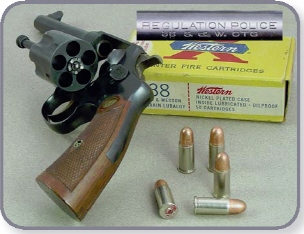
Regulation Police. Old Town Station photo.
ID Key: 5-shot .38 S&W square butt I frame, 4” barrel.

Variations
• Target model worth substantial premium, maybe three times standard value.
• .38 Regulation Police Post Office Version: 38 S&W; 500 were made with a 2” barrel and a small steel plate fastened to the grip butt to add weight; blue finish, marked”R. M.S. P.O. DEPT” on the backstrap. Serial range 47440 - 48127 in the .38 Regulation Police series; 500 manufactured. Shipped in Jan. 1938. 50 - 100% premium.
The .38 Regulation Police (Postwar)
– Pre-Model 33
Caliber: .38 S&W. Double-action revolver built on the square butt I frame with five screws, similar to prewar production with postwar design hammer block, now fitted with the “flat latch” thumbpiece; 4” barrel, 1/10” round blade front sight with a square notch rear, blue or nickel finish, 5-shot fluted cylinder with a nominal length of 1.25”. Checkered diamond walnut stocks with S&W monograms (see previous listing for description of stocks and grip frame configuration). Post-war versions are found built on the I frame with five screws and the Improved I frame with four screws and three screws with a coil mainspring rather than the leaf main spring. Later built on the slightly longer J frame. Regulation Police markings were deleted as existing stock was used. Became the Model 33. Serial number range 54475 - 122678. Manufactured c. 1949 - 1969.

Variations
• Target Model, rare, worth probably three times standard value.
AUCTION BLOCK
Target Model Regulation Police, “as new in box” - $3,080 - Supica’s Old Town Station, Oct. 2003.
• Premium for original red box.
Production Changes
• 1949: Begin postwar production.
• 1953: Introduce Improved I Frame (four screw).
• 1956: Upper sideplate screw eliminated (three screw).
• 1957: .38 Regulation Police continued as the Model 33 – see next section.
Note: Regulation Police vs. Terrier – Generally, the Regulation Police model will have a 4” barrel with square butt grips, with the distinctive cut on the backstrap of the grip frame to fit the special grips. The Terrier has a 2” barrel with a round butt. A 2” barreled square butt .38/22 revolver in .38 S&W has been observed, and we’re unsure which model that would be considered (assuming it was factory original).
The .38/32 Terrier (Pre-War)
Caliber: .38 S&W. Double-action revolver built on the round butt I frame with five screws; 5-shot fluted cylinder with a nominal length of 1.25”; 2” pinned round barrel. Available in blue or nickel finish, with stocks of black hard rubber and occasionally found with checked walnut with S&W monograms usually numbered to the gun; 1/10” round blade front sight, with a square notch cut rear sight. The .38/32 indicates this is built on the .32 Hand Ejector I frame in .38 S&W caliber, i.e., a 2” barreled version of the .38 Regulation Police, built on a round butt frame with the standard production thumbpiece. Serial numbers are found on the butt, cylinder face, barrel flat and yoke, with assembly numbers on the yoke, yoke cut and inside the sideplate. Barrel markings are “Smith & Wesson .38 S&W CTG.” on the barrel’s left side with no markings on the right. The S&W trademark is found on the sideplate with “Made In U.S.A.” on the right side of the frame. .240” smooth trigger with .240” checked hammer spur. Serial numbers 52241 and 54288 were the authors’ examples. Pre-war serial number range 38976 - 54474 in the .38 Regulation Police series. Produced c. 1936 - 1940.
ID Key: 5-shot .38 S&W round butt I frame with 2” barrel.

Premium for factory nickel.
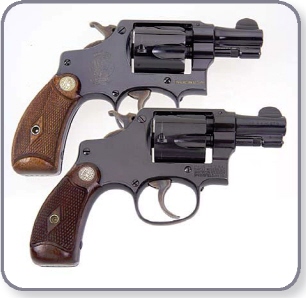
Pre-war and post-war Terriers. Tom Horwedel collection; Paul Goodwin photo.
The .38/32 Terrier (Postwar)
– “Pre-Model 32”
Caliber: .38 S&W. Double-action revolver built on the round butt I frame with five screws. Previously produced as the .38/32 Terrier pre-war but now fitted with the post-war hammer block; 5-shot fluted cylinder with a nominal length of 1.25”. Later post-war versions are found built on the Improved I frame with four screws and three screws and a coil mainspring rather than the leaf main spring. Later built on the slightly longer J frame; 2” pinned barrel marked “38 S&W CTG.” on the right side, checked diamond walnut grips, available in blue or nickel finish. The frame has a small S&W trademark on the left side; 1/10” serrated ramp front sight with square notch rear. Found with three different styles of the flat-latch thumbpiece. Approximate postwar serial range is 54474 - 122678 in the .38/.22 Regulation Police serial number series. Weight is 17oz. Manufactured c. 1948-– 1974.

Production Changes
• 1948: Postwar production.
• 1953: Introduce Improved I frame (four screw).
• 1955: Upper sideplate screw eliminated (three screw).
• 1957: Production continued as the Model 32.
Boxes
Original prewar production shipped in a red, two-piece cardboard box. Post-war and late 1950s production shipped in a blue tw- piece box with metal corners, measuring 7-3/4” X 4-3/4”. Bottom half with statement of liability and warranty dated “April 15, 1955” printed inside. The gun is shipped wrapped in oil paper, with instructions/parts list, 5-1/2” cleaning rod with loop, brass brush and wiper.
J FRAME .38
The J frame was developed as an attempt to package the power of the .38 Special cartridge in a small, pocket-sized revolver. The I frame was too small, although it would accommodate 6-shot .32 or 5-shot .38 S&W configurations. Introduced initially with the Chiefs Special, the J frame was eventually standardized as the smallest frame modern production S&W. At that point, .22, .32, and .38 S&W caliber revolvers that had previously been produced on the I & Improved I frames were continued as J frames.
J-frame S&Ws are often cited as the smallest concealable handgun that chambers an effective defensive round. They have been immensely popular over the decades as police back-up and off-duty guns, as well as civilian concealed carry defensive handguns, and are generally the standard by which all such guns are measured.
The variations that have evolved from the original Chiefs Special have most often been attempts to further enhance the conceal ability or ease of carry of this gun. The alloy frame Airweight variations reduce the weight by several ounces, a very significant improvement in a gun that is carried daily but fired seldom. The shrouded hammer of the Bodyguard configuration keeps the hammer spur from snagging on clothing, yet allows the gun to be carefully cocked for single-action deliberate aimed fire if necessary. The stainless steel variations, beginning with the Model 60, provide rust resistance in a gun that is often carried close to the body and subject to the corrosive effect of perspiration.
The Centennial series deserves some particular commentary. The name comes from its introduction in S&W’s 100th year. Its initial configuration was basically that of a Hand Ejector version of the old lemon squeezer top-break, a “hammerless” (actually a concealed hammer) double-action-only revolver with a grip safety. When the Centennial models were discontinued in the mid 1970s, their passage was loudly lamented by many, and the little guns were eagerly sought after both by collectors and individuals wanting the best in a pocket revolver. Demand must generate supply, because the Centennials were reintroduced in the 1990s, without the grip safety device, to critical acclaim. In the mid-1990s and for the first time, the powerful .357 Magnum round was chambered in a J-frame revolver, resulting in the Model 640-1, a defensive handgun that arguably offered the most power per ounce of gun of any model on the market.
In February of 2001, this trend was continued in an even lighter weight package – the Airlite Sc series, which brought to the marketplace a 10.9-oz. S&W chambered in .357 Magnum with the Model 340. These later models are covered in detail in the next section on numbered model Revolvers.
For photos of the Chiefs Special and Bodyguard models, refer to the next section on numbered models.
SAFETY NOTE
The term “pocket pistol” does not mean it is safe or advisable to carry a loaded revolver loose in the pocket! A gun carried in such a manner will seldom stay in a convenient accessible position, and, more importantly, may be accidentally fired with fatal consequences. There are pocket holsters available that cover the trigger guard, position the revolver properly in the pocket, and enhance safety considerably.
The .38 Chiefs Special – “Pre-Model 36”
Caliber: .38 S&W Special. Double-action revolver built on the round or square butt steel J frame with five screws. S&W’s first introduction of a small frame revolver to fire the .38 S&W Special cartridge. This was a major frame redesign as the frame was made longer and taller using a coiled mainspring rather than the standard leaf spring. This design led to the Improved I frame for all other I frames in other calibers, and ultimately all were converted to the J frame. The 5-shot fluted cylinder has a nominal length of 1.52” to accommodate the .38 S&W special cartridge; 2” round pinned barrel with round butt or 3” barrel with square butt. Blue or nickel finish. Very early production versions are found with a round blade front sight on a five-screw round butt frame with a standard thumbpiece (which quickly changed to a flat latch thumbpiece; examples found up to serial number 61 had the standard thumbpiece) and smooth backstrap and forestrap with a somewhat rounded trigger guard. Transitional variations are found with five-, four- and three-screw frames with ramp front sight, the earliest of which is not serrated; checked diamond walnut grips, 1/10” serrated ramp front sight with square notch rear sight, .240” service hammer with .240” serrated trigger, later changed to .312” smooth combat trigger. Approximately 1,740 were manufactured with target sights (see the Model 50).
Earliest production examples had shorter grips and grip frame from the I frame (not interchangeable with slightly later production J frame grips due to overall length) with a half round front sight blade or ramped front sight and a more rounded trigger guard. Most of that had changed by 1952 or 1953 to the longer trigger guard with a serrated ramped front sight and the standard J frame size. Serial number range 1 - 786544 numbered in an original series. Produced c. 1950 – 1999.
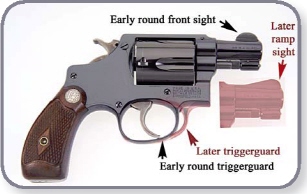
Early Chiefs Special with features compared to later standard production. Tom Horwedel collection, Paul Goodwin photo.

PRICE CHECK
Early production, round front sight, “99%”, medallion pearls, listed at $1,275 – David Carroll, 2006.
Russ Smith engraved for factory employee, carved ivories, pre-36, listed at $2,950 – David Carroll 2006.
Variations
• Substantial premium for early variations (sometimes called “Baby Chiefs Specials”). Earliest guns with a half moon front sight and small trigger guard may bring three to four times standard values. Next variation with ramp front sight but still retaining the small triggerguard may bring a 50% premium.
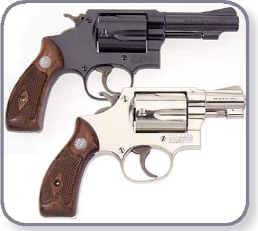
3” blue and 2” nickel Chiefs Specials. Tom Horwedel collection; Paul Goodwin photo.
• Premium for early red box.
• Premium for smooth ramp front sight.
Production Changes
• 1951: Slightly larger frame and trigger guard.
• 1952: Introduction of square butt at approximately serial 21342.
• 1953: Elimination of screw in trigger guard, larger grips (four-screw).
• 1955: Delete upper sideplate screw at approximately serial 75000 (three-screw).
• 1957: Chiefs Special continued as the Model 36 (see next section).
The Chiefs Special Target
See the Model 50 in next section for details on this model.
Pre-model number Chiefs Special Target Models, similar to the Chiefs Special but with adjustable rear sight, have been found in the 55000 - 57000 serial number range. Factory letter advised.
Pre-Model number Chiefs Special Target may go for $1500 ANIB.
The .38 Chiefs Special Airweight
– “Pre-Model 37”
Caliber: .38 S&W Special. Double-action revolver built on the round or square butt alloy J frame with four screws and 5-shot fluted cylinder with a nominal length of 1.52”. Originally built with alloy frame and alloy cylinder weighing 10-3/4 oz., later built with a steel cylinder due to cracks in the alloy cylinders; 2” barrel with round or square butt or 3” barrel with square butt only. Available in blue or nickel finish. Early versions have a .240” service hammer with .240” serrated trigger; later versions have a .312” smooth combat trigger. Earliest production frames were a five-screw alloy frame with a rounded trigger guard and a shorter grip and grip frame; examples of this frame are extremely rare and have been found in a serial area of 13000. (Also like those of the early Chiefs Special, these grips are about 1/8” shorter and not interchangeable with later production.) Later production is a four-screw frame with a slightly longer trigger guard and a slightly longer grip frame. These early four-screw versions also have been observed with a bent wire cylinder stop spring rather than a conventional coil spring. The barrel is pinned, with a serrated ramp front sight withsquare notch rear, original flat latch cylinder release and checkered walnut grips.
The earliest single military order was for the 5-shot Aircrewman revolvers to the U.S. Air Force for 609 units, all with four-screw frames.
About 3,777 were manufactured with an alloy cylinder. Alloy cylinders have been found up to serial 44577, with approximately 900 manufactured in square butt configuration and the remainder in round butt. Earliest production may have a small lock screw on the upper sideplate screw. “Airweight” is marked on the barrel on all known examples except the Aircrewman variation. Original serial number range approximately 13000 – 786544, numbered in the Chiefs Special series. Produced 1952 - present.
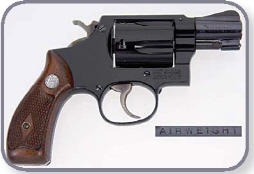
Chiefs Special Airweight with five-screw frame. Nahas collection, Paul Goodwin photos.

Variation
• Premium for original alloy cylinder - typically NIB $1500, Exc $800. Note: Do Not Fire!
• Substantial premium for early 5-screw guns.
Production Changes
• 1951: Introduced with a 5-screw frame (rare; many were X numbered), quickly changed to four-screw for first production run.
• 1952: Earliest production was the Baby Aircrewman production run of 609.
• 1954: Alloy cylinder replaced with steel.
• 1954 - 1955: 312 reported manufactured with target sights and 3-1/2” barrel but not yet observed.
• 1955: Eliminate upper sideplate screw (three-screw).
• 1957: Continued as the Model 37 (see next section).
The Aircrewman (Baby Aircrewman)
Caliber: .38 S&W Special. Double-action revolver built on the alloy J frame with four screws, 5-shot alloy cylinder, fixed sight; 605 Aircrewman versions, serial numbers “A.F.NO. 1795” – “A.F.NO. 2399” were shipped to the U.S. Air Force in 1953. Four others went to the Springfield Amory . Marked with “AIRCREWMAN” on the barrel and “PROPERTY OF U.S. AIR FORCE” on the smooth backstrap, P proof mark over the trigger guard with air force medallions in the grip circles. Most were destroyed; few authentic examples exist. Estimated that 10 -15 have survived. Beware of many counterfeit examples! Weight 10.5 oz. Produced c. 1952.

Baby Aircrewman. Nahas collection, Paul Goodwin photo.
Also see discussion of related K-frame Aircrewman revolvers earlier in this section.
Pricing
Too rare to estimate. Typical pricing $3700 - $5500 in average condition.
The Bodyguard Airweight
– “Pre-Model 38”
Caliber: .38 S&W Special. Double-action revolver built on the round butt alloy J frame with four screws, very similar to the Chiefs Special Airweight with the obvious distinguishing characteristic of having the frame built up at the top rear to form an integral shroud for the hammer. The intent was to minimize the possibility of the hammer spur snagging on clothing when the revolver was drawn from concealment while still allowing manual cocking of the hammer for deliberate single-action shooting (which is impossible if the hammer is completely concealed as on the Centennial Models). The Bodyguard Airweight is also unusual in that it was introduced as an alloy frame lightweight model before the heavier steel frame counterpart (the Model 49 Bodyguard, introduced 1959). Five-shot steel fluted cylinder with a nominal length of 1.52”. Alloy frame with a steel barrel and steel cylinder, shrouded hammer, 2” pinned barrel with some production of 3” barrels (very rare). Alloy cylinders are not reported on this model. Blued or nickel aluminum finish, walnut diamond grips, flat latch thumbpiece in three variations, “Airweight” stamped on the barrel. Also found in combinations of nickel cylinder with blue frame and barrel (scarce). Serrated ramp front sight, .240” shrouded service hammer, .312” smooth trigger. Serial range 66000 - 786544 in the Chiefs Special series. Weight is 14 oz. Produced c. 1955 – 1999.

Variations
• Premium for nickel.
• Original 3" barrel: approximately three times standard price.
• One 1950s-era source reports that a Bodyguard prototype serial number 68519 was shipped to Police Equipment Company 8/16/1955. The same source reports the first production gun as serial number 73780, manufactured 12/16/1955.
Production Changes
• 1956: Eliminate upper sideplate screw.
• 1957: Continued as the Model 38 (see next section).
The Centennial – “Pre-Model 40”
Caliber: .38 S&W Special. Double-action-only revolver built on the round butt steel J frame with four screws. Similar to Chiefs Special but with the distinctive features of “hammerless” design (actually concealed hammer) and lemon-squeezer style grip safety on grip frame backstrap with 6-line serrations. Five-shot fluted cylinder with a nominal length of 1.52”, blue or nickel finish, 2” pinned barrel, fully concealed hammer, checked diamond walnut or smooth wood high horned grips, smooth backstrap, .240” serrated trigger (some early versions with smooth trigger). Flat latch thumbpiece in three variations, 1/10” serrated ramp front sight with square notch rear. This model has a pin stored under the grip to lock the backstrap safety down but the pin is rarely found. Prototype X85 has a stippled backstrap safety and no provisions for the lock down pin in the backstrap. Numbered concurrently with the Model 42. Weight 19 oz. Serial number range in an original series 1 – 30160. Produced c. 1952 - 1974.
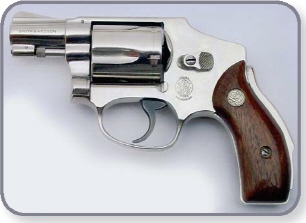
Centennial. ArmchairGunShow.com photo.

Variations
• Premium for guns in original red box.
• Nickel will bring 25 to 50% premium.
Production Changes
• 1955: Eliminate upper sideplate screw.
• 1957: Continued as the Model 40 (see next section).
The Centennial Airweight
– “Pre-Model 42”
Caliber: .38 S&W Special. Double-action-only revolver built on the round butt alloy J frame with four screws; a lightweight version of the Centennial Model. Five-shot fluted cylinder with a nominal length of 1.52”, steel cylinder (37 manufactured with an alloy cylinder), blue or nickel finish, 2 inch pinned barrel, grip safety on the backstrap, checked diamond walnut or smooth wood high horned grips, fully concealed hammer, .240” serrated trigger. The flat latch thumbpiece is found in three variations. This model has a pin stored under the grip to lock the backstrap safety down, but, like the all-steel model, is rarely found. “Airweight” marked on the barrel. Numbered concurrently with Model 40. Very early production may have a small lock screw on the upper sideplate screw. Serial range of 1 - 30160 in an original series. Produced c. 1952 – 1974.

Variations
• Early guns with aluminum alloy cylinder worth five times standard value.
• Nickel: twice blue value.
• Nickel/blue “two tone”: scarce, worth two to three times premium.
Production Changes
• 1955: Eliminate upper sideplate screw.
• 1957: Continued as the Model 42 (see next section).
N FRAME .38
When S&W began development of a more powerful round than the standard .38 Special (a process that eventually culminated in the development of the .357 Magnum), they wanted a stouter platform than the standard K frame. The obvious choice was the big N frame, originally developed for .44 Special caliber rounds. The .38/44 (.38 caliber on a .44 frame) Heavy Duty and Outdoorsman series was the result. The .38/44 round was basically a hot-loaded .38 Special and was later renamed the .38-.44 S&W Special and later called the .38 Special High Velocity. This round should not be confused with the older .38/44 target round developed for the New Model No. 3 Target Model (see comments under that model listing in the top-break section). This cartridge is also not recommended for the lighter frame S&Ws. The Heavy Duty is a fixed-sight revolver; the Outdoorsman is the adjustable-sight version.
Transitional Models
Previous editions of this book did not fully explain the early Post-WWII Transitional N-frame models. More and more collectors are recognizing the rarity of these variations, and paying accordingly.
Generally speaking, the Transitional revolvers were those first produced in the late 1940s when S&W returned to production for the civilian market after WWII, with the addition of the new safety hammer block (as indicated by an “S” serial number prefix on K and N frames).
Generally they were about identical to corresponding prewar models, with the exception of post-war matte or “satin” finish (less highly polished than pre-war guns). Beginning around 1950, S&W design improvements including the short action began to be incorporated in their N-frame revolvers. A factory document from the era notes the first N frame wide spur target hammer, typical of 1950 Models, introduced on Jan. 13, 1950. Then in the late 1950s, these same designs were assigned model numbers rather than descriptive names.
Accordingly, the evolutionary path for most N-frame models during the mid-20th century would be:
1) Up through about 1941: Pre-war model.
2) Wartime production: Most non-military production was more or less discontinued during WWII.
3) 1945 to about 1950 - Transitional Model (Post-war): Pre-war features with post-war finish and post-war serial number range. Improvements may be phased in on some models.
4) About 1950 to about 1957 – Post-war, Pre-Model #XX: Incorporates the 1950 design improvements, but before model numbers were assigned. Many collectors will call these “pre-models” – “Pre-Model 27,” “Pre-Model 29,” etc.
5) Beginning about 1957, Numbered Models: Model number stamped on the frame under the cylinder yoke.
Identifying characteristics of Transitional N-Frames: The usual quick visual clue for a Transitional will be the combination of both:
• A pre-war long action including distinctive flat sided pre-war style hammer without the flared side on the cocking spur, combined with…
• A post-war matte or satin finish and “S”-prefix postwar serial number and a hammer block safety.
Other characteristics vary. Many of these were phased in, so the exact characteristics of Transitional Models may show variations. Since guns were not necessarily assembled in serial number order: older features may appear on higher numbered guns. Some features to consider on Transitionals include:
• One line “Made in U.S.A.” frame marking (no “Marcas Registradas”).
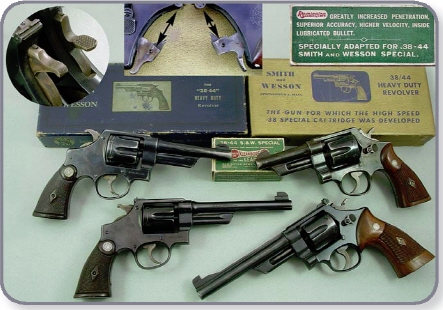
N-frame .38s: On the left Prewar .38-.44 Heavy Duty (top) and .38-.44 Outdoorsman (bottom). On the right, Model of 1950 Heavy Duty (pre-Mod. 20) and Outdoorsman (pre-Mod. 23). Insets show differences in pre-war vs. Model 1950 features – hammer configuration and long vs. short action. ArmchairGunShow.com photo.
• Ejector head slightly larger than rod diameter.
• Grips may be of pre-war configuration, but with a smaller checked area, coarser lines, and postwar medallions. Post-war K frames may have prewar grips, especially on round butt models.
• Postwar Transitional target models will generally have the micrometer click style adjustable rear sight.
Note: In addition to the N-frame Transitional Models, there are also post-war Transitional Model .22/.32 Kit Guns, on the Improved I frame. In that case, the design changes were introduced c. 1953 instead of 1950. Post-war K frame ‘S” series M&Ps also will have Transitional Models.
The .38/44 Heavy Duty (Prewar)
Caliber: .38 S&W Special or .38/44 S&W Special. Introduced April 1930. Double-action revolver built on the larger square butt N frame with five screws; 6-shot cylinder with a nominal length of 1.57”, diamond walnut service grips changed to Magna style by 1938. Available with blue or nickel finish. Standard barrel length was a 5” round pinned barrel, with limited production of 4” or 6-1/2” length barrels. Longer and shorter barrels have been discussed in the factory literature but no examples have been observed. Shrouded extractor rod, fixed sights consisting of a forged 1/10” round blade front sight, with a square notch rear sight cut into the top strap; smooth backstrap and forestrap. “.38 S&W Special CTG” on the right side of the barrel, “Smith & Wesson” on the left barrel side and patent dates and address on the top for 5” and 6-1/2” models. 4” models do not have any patent date or address markings on top of the barrel. This model has a small spring loaded plunger on the yoke to assist in locking it open, visible by disassembly only. A small S&W trademark is on the frame’s left side and has been also observed on the sideplate generally after 1936 production. “Made in U.S.A” is on the right side of the frame; .265” serrated trigger with checked hammer spur. Twelve are documented to be chambered in .45 Colt, some of which were shipped in 1937, 1938 and 1939 to law enforcement.
Originally built for a high-powered .38 Special round, at times called the .38 Super Police, predecessor of the .357 Magnum. Serial number range 35037 (3/10/1930) - 62335 in the .44 Hand Ejector 3rd Model series. Guns manufactured from 1930 - 1935 shipped in maroon boxes and from 1935 - 1940 in blue picture boxes. Weight is 41 oz. 11,111 manufactured c. 1930 – 1941.

Variations
• .38/44 Police Target Model: Reported, but not verified, that during 1930 some .38/44 HDs were factory-fitted with adjustable target rear sight and Call gold bead front sights, and sold by special order as “.38/44 Police Target Models.” This was before the introduction of the adjustable-sighted .38/44 Outdoorsman in 1931. The one reported was in the 351xx serial number range.
• British Columbia Police: It appears that in Oct. 1940, approximately 100 .38-44 Heavy Duties with 5” barrels and lanyard rings were supplied to the British Columbia police. More information and some serial numbers can be found in the SWCA Journal, 25th Anniv. reprint, Book 2, pg. 468.
• 4" and 6-1/2" barrel lengths bring a three to four times premium.
• .45 Colt version brings substantial premium when found; reported around a dozen made in the late 1930s with multiple guns reported shipped to the Imperial Co., CA, Sheriff. A couple of recent sales reported over $10,000 but under $15,000.
• Premium for Magna grips.
• 50% premium for nickel.
• It is reported that the first “S”-prefix .38/44 Heavy Duty was serial number S62589, delivered 5/17/1943; one of very few commercial revolvers assembled from parts on hand during WWII.
The .38/44 Heavy Duty Transition
(Postwar Transitional)
Caliber: .38 S&W Special. Reintroduced in June of 1946; double-action revolver built on the square butt N frame with five screws, having 4” or 5” barrels (6-1/2” rare). Reintroduced postwar with an “S” serial prefix beginning at approximately S62496, incorporating a new slide action hammer block. A short throw hammer was introduced in 1948 at approximately serial number S72300. Front sight is a 1/10” forged round blade with a square notch rear sight. Typically a polished blue or nickel finish; 6-shot fluted cylinder with a nominal length of 1.57”. The extractor rod has a knob that is found in diminishing diameters until it is standard as the same diameter as the rod and is only a knurled end at the end of the tube. This postwar model has the spring-loaded locking ball bearing or plunger in the yoke deleted. Most postwar transitional guns will have the long cocking action hammer and trigger. Checked Magna-style diamond walnut grips; shrouded extractor rod. Some early postwar guns are known with prewar Magnum barrels with checkered ribs. This postwar model has the “Made in U.S.A.” marking in early models and will be found with the four-line address as it is produced closer to 1950. A large S&W trademark is generally found on the sideplate. Serial number range is approximately S62496 - S75206 with about 2500 manufactured c. 1946 - 1950. Guns were shipped in maroon or gold boxes.

Variations
• Premium for 6-1/2" barrel.
• Premium for nickel finish.
Production Changes
• 1948: New Hammer block and long throw hammer phased in beginning approximately serial number S72300, marking eventual end of Transition Model.
The .38/44 Heavy Duty Model of 1950
– “Pre Model 20”
Caliber: .38 S&W Special. Introduced in September of 1950. Double-action revolver built on the square butt N frame with five screws with 4” or 5” barrels (6-1/2” rare). Short throw hammer and trigger. Front sight is a 1/10” forged round blade, with a square notch rear sight. Polished blue or nickel finish, 6-shot fluted cylinder with a nominal length of 1.57”. Checked Magna-style diamond walnut grips, shrouded extractor rod. This postwar model has the “Made in U.S.A.” with three additional lines marking. A large S&W trademark is found on the sideplate. The extractor is the same diameter its entire length. A factory document from the era notes the first short action HD as serial number S75514, 11/18/1949. However, that same number is listed elsewhere in the same document as being the first short-action .357 Magnum on 11/13/1950. The 1950 Model became the Model 20 in 1957. Serial number range is spread over a wide range of from approximately S75000 - S256133 with 9,493 manufactured c. 1950 - 1966.

PRICE CHECK
.38/44 HE, gold box, “excellent…99%”, listed at $1,250 – Old Town Station Dispatch, 2005.
Variations
• 6-1/2" barrel brings premium.
• Austin Police Dept.: 249 4” nickel handguns shipped 1952 - 1964, including 50 Model marked 20-2. The range of serial numbers is in the S88XXX, S89XXX, S1480XX, S154xxx, S147xxx, S149xxx, S150xxx, S151xxx and S255xxx ranges. Specific serial numbers of two shipments can be found in the SWCA Journal, 25th Anniv. reprint, Book 1, pg. 476.
Production Changes
• 1956: Delete upper sideplate screw.
• 1957: The .38/44 Heavy Duty continued as the Model 20 (see next section).
The .38/44 Outdoorsman (Prewar)
Caliber: .38 S&W Special or .38/44 S&W Special. Introduced in November of 1931. Double-action revolver built on the square butt N target frame with five screws. Target version of the Heavy Duty; 6-1/2” round pinned barrel with extractor shroud and markings of “Smith & Wesson” on the left and “38 S&W Special CTG” on the right with patent dates on the top; .265” serrated trigger and checked hammer. 6-shot fluted cylinder with a nominal length of 1.57”. Blue or nickel finish, with checked diamond walnut service grips going to Magna style by 1936; Patridge front sight. The adjustable rear sight leaf is rounded and contoured to the frame. A small S&W trademark is found on the frame’s left side, with “Made in U.S.A.” on the frame’s right side. Serrated backstrap and forestrap with six grooves. Serial number range 38939 - 62077 in the .44 Hand Ejector 3rd Model series. Another source reports the last prewar Outdoorsman as serial number 62023 on 1/3/1941. Total production of 4,761 manufactured c. 1931 – 1941.

PRICE CHECK
• Pre-war 38/44 Outdoorsman, in box, “finest condition to be found,” listed at $2,500 – David Carroll, 2006.
• Another, this one a zero serial number “Club Gun,” built for Danny Wesson, “97%”, listed at $6,500 – same source.
Variations
• Premium for Magna grips.
• Original grip adapter, add $800 to $1,000 in higher conditions.
• Special order 5" barrels reported, with serial number 58100 shipped to the City of Wheeling, WV. One collector reports the 5" barrel variation is sometimes, but not always, called the “McGivern Model”; not verified.
The .38/44 Outdoorsman Transition
(Postwar-Transitional)
Caliber: .38 S&W Special. Reintroduced with a new slide hammer block and an “S” serial prefix beginning at approximately S62940 in August 1946; double-action revolver built on the square butt N target frame with five screws. Similar to the prewar model with postwar improvements; 6-1/2” pinned barrel with a shrouded extractor (4” rare, with a small production run of 5” barrels produced and estimated at 50 - 100); 1/8” or 1/10” Patridge front sight, micrometer rear sight click-adjustable for windage and elevation. The barrel is marked with “Smith & Wesson” on left side, “38 S&W Special” on the right side. 6-shot fluted cylinder with a nominal length of 1.57”; .265” grooved trigger. Blue finish that is usually flat in appearance (nickel rare); checked Magna diamond walnut grips with S&W monograms. Most transitional guns found with the “Made in U.S.A.” mixed with the three additional address lines. Some early postwar guns are known with Prewar Magnum barrels with checked ribs. Serrated backstrap and forestrap with six grooves. A large S&W trademark is found on the sideplate. Approximate serial number range S62940 -S75000. Approximate production is 2,326 manufactured c. 1946 - 1949.

The .38/44 Outdoorsman Model of 1950
– “Pre-Model 23”
Caliber: .38 S&W Special. Introduced September of 1950; double-action revolver built on the square butt N Target frame with five screws. Introduced with a raised ribbed barrel and a micrometer click rear sight and short throw hammer and trigger; 6-shot fluted cylinder with a nominal length of 1.57”. “S” serial prefix, Patridge front sight, shrouded extractor, .400” target hammer, (.500” optional) with .265” serrated trigger. The blue finish is now a polished blue or nickel finish. The extractor rod is now of uniform diameter with knurling at the end. The S&W trademark is now found on the sideplate. Magna-style diamond walnut grips. Approximate serial number range S75000 - S261999 in the N frame “S” series with a total of 6,039 manufactured c. 1950 - 1966.

Variations
• 25 - 50% premium for bright polish finish.
• Premium for special order features.
Production Changes
• 1950: Introduce ribbed barrel and micrometer rear sight.
• 1952: Delete 1/10” Patridge front sight.
• 1956: Delete upper sideplate screw.
• 1957: The .38/44 Outdoorsman continued as the Model 23 – see next section.
The .38/44 Heavy Duty/Outdoorsman Alloy Frame
Caliber: .38 S&W Special. Double-action revolver built on the square butt Alloy N frame with five screws. A small group (about 12) of aluminum alloy N frame handguns were made in various calibers and configurations as specials in 1955. Several of these were of a 38/44 configuration with a steel cylinder, with both 4” and 5” barrels being made. “S” serial prefix and “X” serial prefixes have been observed. It was verified that both target and fixed sight models were made in blue and nickel finish. Also known as The Light Heavy Duty, this was reportedly made for the police market on a test basis but was not widely accepted. These alloy frames are 6 oz. lighter than their steel counterparts. Five are known in private collections. Last known traded price was $14,000 in 1996. See also .22 Hornet caliber.
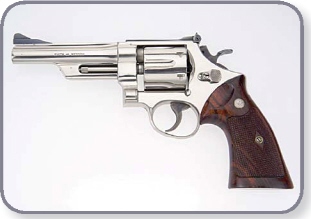
Very rare alloy frame Outdoorsman. Nahas collection, Paul Goodwin photo.
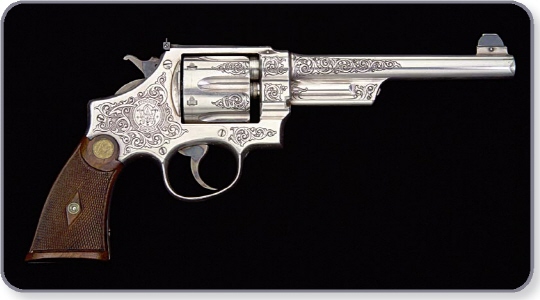
Engraved Triple Lock Target. David Carroll collection, photo by Paul Goodwin.
.44 SPECIAL
The .44 caliber has always been S&W’s first choice in full-size service revolvers. All of the big .44s seem to have a special appeal for collectors. The .44 Triple Lock in particular has something of a cult following. A number of knowledgeable individuals have called it the finest revolver ever made. It also marked the introduction of the acclaimed .44 Special cartridge, predecessor of the .44 Magnum.
Target Models
.44 Hand Ejector First, Second and Third models were standard issue with fixed sights. When one of these is found with factory original adjustable target sights it will bring a premium.
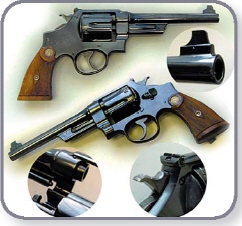
Details of Target Model sights, and of third locking lug area on Triple Lock. ArmchairGunShow.com photo.
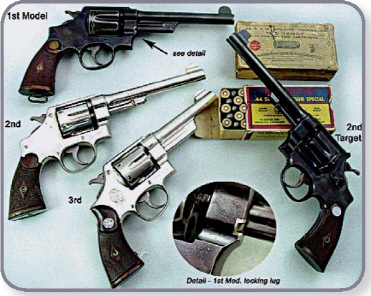
Pre-war .44 HE variations: 1st Model Triple Lock with detail of locking lug area; 2nd Model lacking ejector shroud, including 2nd Model Target Model (modified hammer spur); 3rd Model brings back the ejector shroud but lacks the third locking lug of the 1st Model.
The .44 Hand Ejector 1st Model
(a.k.a. New Century; Triple-lock; .44 Military, Model of 1908)
Caliber: Various calibers including: .44 S&W special, .44 S&W Russian, .44-40 Winchester., .455 Mark II, .38-40 Winchester., .45 S&W Special. Twenty-three reported manufactured in .45 Colt; 1226 reported manufactured in .450 Eley; 13,753 reported manufactured in .44 S&W Special. Also reported that a small quantity were made in .22 Long Rifle. This model has a third very distinctive lock at the yoke, thus giving this revolver its unique name. Double-action revolver built on the square butt N frame with five screws; 4”, 5”, 6-1/2” or 7-1/2” pinned barrel lengths are found.
Features a 6-shot fluted cylinder with a nominal length of 1.575” when chambered in .44 Special. This is the first side-swing cylinder handgun in the .44 Hand Ejector series. Offered in blue or nickel finish on a square butt N frame with smooth backstrap and forestrap. Checked diamond walnut grips with S&W medallions , service or target sights. Five-screw frame with a shrouded extractor rod, this being a distinctive feature when combined with the third lock. The front sight is a round blade with a square notch rear on fixed sight versions, .260” checked hammer, .312” smooth trigger. This model also has a spring loaded plunger in the yoke to assist holding the cylinder open. Use caution – the plunger and spring can fly out when the yoke is removed.
The third lock is held in place with a small screw in the yoke cut of the frame and is easily removable. Serial numbers are found on the cylinder, barrel, frame butt and the yoke.
The serial numbering of this model is bit complex, especially when considered in conjunction with the similar .455 Hand Ejector First Model revolver serial numbering system. For a full discussion, please see Neal & Jinks. Weight is 38 oz. for a 6-1/2” barrel model. Serial number range 1 - 15375 in the .44 Hand Ejector series with 15,375 manufactured c. 1907 – 1915.

PRICE CHECK
44 HE 1st, “excellent plus…99%”, listed at $2,650 – Old Town Station Dispatch 2004.
Variations
• Unusual chamberings: Calibers other than .44 Special or .455 are worth multiples of the standard model values. In the 12000 - 13000 serial number range some .45 caliber handguns will be found, most believed to be originally .455, some converted to .45 Colt, possibly by the factory. Others that may have been converted to .45 Colt by the factory are listed in Neal & Jinks, in the 98xx serial number range with guns from that group having been observed in both .455 &.45 Colt. A number of Triple-locks originally shipped in .455 will be found today converted to .45 Colt, so a factory letter is important in that caliber. Some documents from the 1950s suggest that perhaps 90% of the production was originally chambered for .44 Special. The same source also indicates almost 8% were originally chambered for .450 Eley; and fewer than two dozen originally in .45 Colt, along with a few special order guns in .44 Russian & .44-40. Other sources report .38-40 Winchester and .22 Long Rifle as original chamberings, presumably a few special order guns.
• .455 Caliber Triple-locks: A number of .44 HE 1st Models were converted to the .455 Mark II caliber for shipment to England. A list of the serial numbers of 666 of these guns converted for the British military will be found in Neal &Jinks, which also indicates over 800 total were converted with the balance going to commercial sales. Note that many .455 & .45 caliber Triple-lock style revolvers encountered will actually be .455 Mark II HE 1st Models (see listing later in this section). Even those chambered for .455 which are in the .44 HE 1st Model serial number range seem to bring a bit less than if they were still .44 Special, despite the relative scarcity of the .455 chambering. We haven’t seen any indication of what these revolvers were chambered for before conversion; the .450 Eley seems to be so seldom encountered today that one would wonder if those were logical candidates for the in-factory conversion, but that is pure speculation.
• Barrel lengths other than 6-1/2" will bring a premium, often 50% or more.
• Premium for nickel finish.
• Target model: Target versions have a Paine pinned front sight, or bead front sight, smooth backstrap and smooth front tang, with a smooth trigger and smooth rear sight blade leaf contoured to the frame. Reportedly checked or grooved triggers were available on special order. Target models worth around three times the standard model. Target versions are scarce.
AUCTION BLOCK
.44 HE 1st Target Model, “excellent… over 90%” - $4,025 – Rock Island Auction, April 2006.
PRICE CHECK
.44 HE 1st Target, “99% factory refinish,” listed at $2,500 – Lyle Larkworthy, GunsAmerica.com, 2006.
Several .44 HE 1st Target Models: “excellent,” listed at $4,850; “very good…80%” listed at $2,950; “99% factory reblue” at $2,500; “excellent as factory reworked…99%” at $4,500 – Old Town Station Dispatch, 2004.
Club Gun .44 HE 1st Target, serial number 010, “excellent plus…97%”, listed at $7,850 – ArmchairGunShow.com, 2005.
.44 HE 1st Target, “excellent…95%”, listed at $3,950 – Old Town Station Dispatch, 2006.
• A small number will be found with auxiliary cylinders such as .44-40 caliber and numbered to the frame. Serial number 924 was our example with the main cylinder in .44 Special with an auxiliary cylinder in .44-40 caliber. This is a target model with an ivory bead front sight with an adjustable rear sight numbered to the frame with a 6-1/2" barrel and smooth tangs.
• A very small number are found with a drift adjustable rear sight for the Bisley Target Matches in Great Britain.
• Pre-production Triple-lock in .45 Special caliber, serial number 09, actually thought to be chambered in .45 Frankfort caliber built for U.S. Government tests in 1906 (note that this is prior to the Triple-lock commercial introduction). Serial number 09 is a four-screw frame with the trigger guard screw plugged. The .45 Frankfort was an experimental cartridge before the .45 ACP.
The .44 Hand Ejector 2nd Model
Caliber: Standard caliber was the .44 S&W Special; some also made in .44-40 Winchester, .45 Colt or .38-40 Winchester. Double-action revolver built on the square butt N frame with five screws. Similar to the .44 First Model New Century but without the triple lock feature and the shrouded extractor rod housing. 6-shot fluted cylinder with a nominal length of 1.57” when chambered in .44 Special. Barrel markings are “Smith &Wesson” on the left with “44 S&W Special CTG” on the right and patent dates on the top. Smooth backstrap and forestrap with smooth trigger. Blue or nickel finish, (4” rare), 6-1/2” (standard) and 5” (scarce) round barrel lengths, checked diamond walnut stocks and later with magna style grips about 1936 production. Service sights consist of forged round blade front sight with notch cut rear sight., .260” checked hammer spur. Most but not all are found with a lanyard ring on the butt. Target versions have a Patridge blade front sight on a raised pinned boss with adjustable rear sight rounded and contoured to the top strap and frame. Serial number range begins around 15376 with examples reported into the 59XXX range, in the .44 Hand Ejector series with 17,510 manufactured c. 1915 - 1940.

Variations
• Calibers other than .44 Special worth 75 - 100% more. Only 565 made in .44-40, including 32 5" blued in serial number range 30052 - 30204 and 23 6-1/2" nickel in serial number range 33763 - 33834. Partial listing of serial numbers can be found in the SWCA Journal, 25th Anniv. reprint, Book 2, pg. 430. Reportedly 727 were manufactured in .45 Colt with a 6-1/2” barrel.
• Nickel worth premium.
• Barrel lengths other than 6-1/2" will bring a substantial premium.
• Target Models: Patridge front sight on a raised and pinned boss. Late Target Models have a serrated backstrap and serrated front grip tang. Smooth trigger with checked hammer. Pre-1931 examples may be found with a two-screw adjustable rear sight leaf contoured to the frame and some after 1931 may be found with a third screw at the rear of the sight leaf. A small S&W trademark is found on the frame’s left side, with “Made in U.S.A.” on the right side, Barrel markings are “Smith & Wesson” on the left side, with caliber on the right side and patent dates on the top. Target Models will bring two to three times standard values.
PRICE CHECK
.44 HE 2nd, Target, “excellent…95-97%”, listed at $1,750, Old Town Station Dispatch, 2005.
Two .44 HE 2nd Targets, one “excellent…97%”, listed at $1,950; the other shipped to Alaska, “excellent 95-97%” @ $1,950 – same source, 2004.
• Early serial numbers: Some 4" barrel 2nd Model 44 HEs will be found in the 144XX serial number range (a range usually associated with the earlier 1st Model Triple-lock).
• Some will be observed built on military inspected frames, probably originally for the 1917 model, with the eagle head mark on the crane cutout and with a factory lanyard ring.
The .44 Hand Ejector 3rd Model
(Prewar) (a.k.a. Model 1926 Hand Ejector, Prewar; “Wolf & Klar Model”)
Caliber: .44 S&W Special. Double-action revolver built on the square butt N frame with five screws. This 3rd Model reintroduced the shrouded extractor barrel due to requests from the dealer Wolf & Klar of Fort Worth, TX, and also has a change in the extractor rod. Note that both 2nd and 3rd Models were produced simultaneously. 6-shot fluted cylinder with a nominal length of 1.57”, round pinned barrel lengths of 4” or 5” with 6-1/2” barrels scarce, blue or nickel finish, checkered diamond walnut stocks with silver S&W medallions. Service sights were a forged 1/10” round blade front with a notch cut in the top strap for a rear sight (target sights are rare, see below), shrouded extractor rod, some found with lanyard ring. Serrated trigger with smooth backstrap and forestrap. A small S&W trademark is found on the frame’s left side with “Made in U.S.A.” on the right. Usually this model was available on special order only and not catalogued until 1940 when it officially replaced the 2nd Model. Serial number range 28358 - 61412 in the .44 Hand Ejector series overlapping the 2nd model. 4,976 were reported manufactured c. 1926 – 1941.

Variations
• It is estimated about 300 were shipped to Wolf & Klar for the Houston Police Dept. in March 1931 with 5" barrels. Stamped with “H.P.D.” and an issue number on the backstrap.
• Small group shipped to Providence Rhode Island Police marked “P.P.D.[#].”
• Target Model Prewar: 6-1/2” round pinned barrel, target sights. An unknown quantity, possibly fewer than 200, were built on the .44 Hand Ejector frame 3rd model of 1926; this target version has a shrouded extractor housing normally with the serial number inside as well as on the butt and cylinder face. This frame has a six-line serrated backstrap and forestrap; 1/10” Patridge front sight pinned on a slightly raised boss. This model has a round barrel with the rounded rear sight leaf contoured to the top strap, adjustable for windage and elevation; .255” wide hammer, .265” serrated trigger. Patent dates are found on top of the barrel, with “Smith & Wesson” on the barrel’s left side, while “.44 S&W Special CTG” appears on the right of the barrel. “Made in U.S.A.” is on the frame above the trigger guard. A small S&W Trademark is found on the left side of the frame under the thumbpiece while the sideplate is blank. The grips are either checked walnut with a diamond around the screw escutcheon with silver S&W medallions or diamond checked Magnas fitted to a square butt frame. The 6-shot fluted cylinder has a nominal length of 1.57”. Weight is 38 oz. Serial range 28358 - 61412 in the .44 Hand Ejector series. Produced c. 1926 - 1941. Worth double to triple premium.
Note: See information on Transition N-Frames at the beginning of the section on .38 caliber N-frames.
The .44 Hand Ejector 3rd Model
(Postwar-Transitional)
(a.k.a. 1926 Model .44 Military)
Caliber: .44 S&W Special. Double-action revolver built on the square butt N frame with five screws, long action hammer and trigger. Reintroduced June of 1946 with a new slide-activated hammer block and is so indicated with an “S” serial prefix; 4” or 5” round pinned barrel lengths with 6-1/2” very scarce. Matte blue or nickel finish, 1/10” forged round blade front sight with square notch cut rear sight; checked Magna style diamond walnut grips with S&W monograms. A small S&W trademark is found on the left of the frame. “Made in U.S.A.” is found mixed with the three additional address lines. Serial range S62489 - S75000. 1,473 reported manufactured c. 1946 – 1949.

AUCTION BLOCK
44 HE 3rd Transitional, gold box, “96%” - $2,415 – Amoskeag Auction, Sept. 2005.
44 HE 3rd Transitional, “97%...fine” - $2,530 – same auction.
Variations
• Target Model: Nominal 6-1/2” pinned barrel length (although cataloged in Dec. 1945, the 4” and 5” barrel lengths are considered very rare), blue finish, 1/8” or 1/10” pinned Patridge front sight with Micrometer click adjustable rear sight for windage and elevation, 6-shot fluted cylinder with a nominal length of 1.57”. N Target frame with .260” checked hammer spur, “S” serial prefix indicating a new postwar hammer block, grooved tangs and serrated trigger. It is estimated that fewer than were 50 produced (one knowledgeable collector estimates around 30). A large S&W trademark is found on the sideplate with “Made in U.S.A.” on the frame. Serial range S62489 - S75000 in the postwar .44 Hand Ejector series, with most having been found in the 71035 - 71970 serial number area. Produced c. 1946 - 1949. Worth double to triple standard value of fixed sight variation.
AUCTION BLOCK
44 HE 3rd Target, “Excellent…over 98%” - $10,350 – Rock Island Auction, April 2006.
PRICE CHECK
44 HE 3rd Target, “Mint,top quality”, listed at $13,500 – David Carroll, 2006.
The .44 Hand Ejetor 4th Model Military
(a.k.a. Model of 1950 .44 Military)
– “Pre-Model 21”
Caliber: .44 S&W Special. Double-action revolver built on the square butt N frame with five screws; 6-shot fluted cylinder with a nominal length of 1.57”, forged round blade front sight and fixed rear sight. Round pinned barrel with lengths of 4” and 5” (6-1/2” scarce), polished blue or nickel finish, shrouded extractor rod with a uniform diameter with a knurled end. Checked diamond walnut Magna-style grips on a square butt frame. Became the Model 21 in 1957. The S&W trademark is now found on the sideplate. Serial number range S75000 -S263000 with 1,200 reported manufactured c. 1950 - 1966.

AUCTION BLOCK
.44 HE 4th, scarce 6.5” barrel, “Excellent…98%” - $4,312 – Rock Island Auction, April 2006.
PRICE CHECK
Pre-Model 21, Micro sights added, “near new appearing,” listed at $3,000 – David Carroll, 2006.
Variations
• Model marked guns will bring premium
– see Model 21 listing.
• Target version brings less – see next listing.
Production Changes
• 1956: Delete upper sideplate screw.
• 1957: Model 1950 .44 Military continued as the Model 21 (see next section).
The .44 Hand Ejector 4th Model Target
(a.k.a Model of 1950 .44 Target)
– “Pre-Model 24”
Caliber: .44 S&W Special. Introduced September 1950. Double-action revolver built on the square butt N frame with five screws; 6-1/2” shrouded and pinned barrel standard with a serrated rib (4” scarce, 5” rare with 5-1/2” extremely rare), all with Baughman front sight. 6-shot fluted cylinder with a nominal length of 1.57”, micrometer click rear sight with Patridge front sight and short throw hammer introduced at serial S75000. Barrel markings of “.44 S&W SPECIAL CTG,” serrated backstrap and forestrap with six lines; .400” target hammer, .265” serrated trigger. A large S&W trademark is found on the sideplate. Made in USA and address markings are the standard four lines of text on the frame. Became the Model 24 in 1957. Serial number range S75000 - S263000 in the .44 Hand Ejector series. 5,050 reported manufactured c. 1950 - 1966.
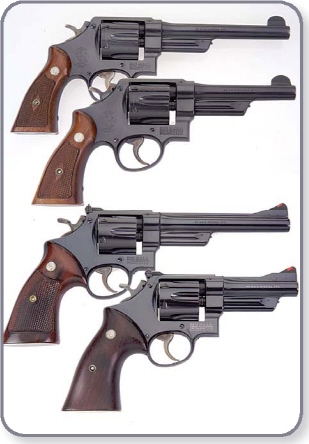
.44 HE 4th Model variations. Top pair are Model 1950 Military (pre-Mod. 21) with scarce long barrel on top gun. The bottom two are Model 1950 Target (pre-Mod. 24) with scarce short barrel on bottom gun. From Paul Goodwin photos.

PRICE CHECK
Pre-24, gold box, “very good to excellent…96-97”, listed at $1,250 – Old Town Station Dispatch, 2005.
Variations
• Premium for rare barrel lengths – 4” (200%), 5” (300%), 5-1/2” (400% or more).
PRICE CHECK
Pre-24, rare 4” barrel, “98.5%”, listed at $3,750 – David Carroll, 2006.
• Bright blue finish will bring 25% premium.
• Model marked guns will bring premium (see Model 24 listing).
Production Changes
• 1956: Delete upper sideplate screw at approximate serial S-175000
• 1957: Model of 1950 .44 Target continued as the Model 24 (see next section).
.44 MAGNUM
THE .44 MAGNUM
by Bob Radaker
The S&W .44 Magnum was a joint development by Smith & Wesson and Remington Arms Company. Many big-bore shooters such as Elmer Keith were pushing the performance of .44 Special handloads in N-frame Hand Ejectors. Keith encouraged S&W president Carl Hellstrom to have S&W produce a revolver capable of withstanding increased pressures, and Hellstrom discussed the feasibility of such a cartridge with R.H. Coleman of Remington Arms Company. Dimensions of a new .44-caliber cartridge called the “.44 Magnum” were finalized in 1954. S&W produced five specially heat-treated prototypes in early 1955. These revolvers were numbered sequentially beginning at S121835.
The first production .44 Magnum, serial number S130927, was completed on Dec. 15, 1955. S&W called this model the NT-430 for N-frame, Target, .430 bore diameter. The second revolver (S130806) was completed December 29 of that year and presented to Coleman. Five additional .44 Magnums were completed in January of 1956 with S130942 being shipped to Julian Hatcher of the NRA and fourth going to Elmer Keith (serial number S147220) on January 27, 1956.
The “Most Powerful Handgun in the World” was announced to the shooting public on January 19, 1956, with a special telecast from Springfield, MA. The NT-430 was initially offered in both a 6” and 4” barrels, blue or nickel finish, at a price of $135.00. Approximately 3100 .44 Magnums were produced in 1956.
The new .44 Magnum quickly gained popularity with shooters and handgun hunters. The .44 Magnum became the Model 29 when S&W assigned model numbers in 1957. The release of the movie Dirty Harry starring Clint Eastwood made the .44 Magnum and the Model 29 known around the world. The “Most Powerful Handgun in the World” acquired a mystique unequaled by any other modern handgun. Interest in the .44 Magnums increased to the point where demand far exceeded supply.
Although the Model 29 is not currently a standard production item, 50 years of manufacture with continuous improvements, engineering changes, multiple configurations, commemoratives and numerous special editions have made the S&W .44 Magnum of special interest to collectors. From the Pre-Model 29 to the Fiftieth Anniversary Model 29-10, a complete collection can become a lifelong pursuit. Prices on the early guns and rarer variations continue to rise.
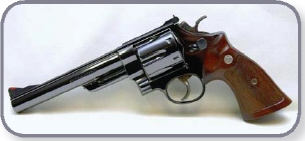
Pre-29, believed to be one of the first few produced. Photo courtesy of Chuck Odom, Paul Goodwin photo.
The .44 Magnum – “Pre-Model 29”
Caliber: .44 Magnum. Introduced in January 1956 as a 6-shot, double-action revolver built on the square butt, five-screw N-Target frame in blue or nickel finish. Initially cataloged in a 4” or 6-1/2” barrel, .500” target hammer, .500” target trigger and target sights consisting of a red ramp insert front sight and a micrometer click rear sight adjustable for windage and elevation with a white outline rear sight blade. The revolver had a typical half lug barrel with a shrouded extractor rod and a fluted, counter-bored cylinder. The grips were diamond checkered goncola alves and had a slight palm swell. Collectors refer to these style grips as “Coke Bottle” grips. Early revolvers also had a serrated backstrap with six grooves while latter pre-29s after S167000 had 10 grooves.
The early NT-430s were shipped in a black or dark blue pebble grain leatherette presentation case with an S&W Insignia and “.44 Magnum” on the top. Early 1956 cases had a button slide release. The interior was lined in blue satin and contained an aluminum (or blue steel) knurled screwdriver and cleaning rod with brass brush and cotton swab. The swab and brush were made with a treaded brass base. Late 1956 first-year presentation cases had a clasp type latch.
Approximately 6500 Pre-Model 29s were produced with the five-screw frame in the serial number range of S130000 to S167500 but revolvers with serial numbers as high as S174500 have been documented as five-screw framed. The serial numbers were stamped on the bottom of the grip frame, the rear cylinder face, inside the yoke, in the ejector rod shroud and under the extractor star. About 3100 of these five-screw 44 Magnums were made in 1956. The majority of the first year production guns were produced with 6-1/2” barrels and blue finish. Four-inch guns began to ship in late 1956. This collector believes that less than 25% of the first-year 44 Magnums have 4” barrels. No 8-3/8” barreled five-screw revolvers have been documented. Nickel finish five-screw revolvers are very rare and will have an “N” stamped on the side of the grip frame and the rear cylinder face. Only a factory letter of authenticity can confirm a revolver’s shipping date, barrel length and finish.
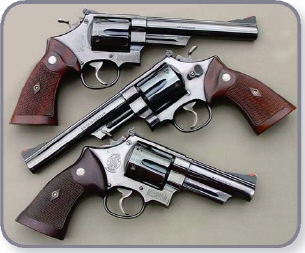
Five-screw pre-29 .44 Magnums. Grips on top two guns have been modified. Old Town Station photo.
Five-Screw Pre-29s

AUCTION BLOCK T
hree five-screw Pre-29s sold – consecutive pair, both “excellent plus,” 99% - $2,420, 98% - $1,760; another “excellent, 96-97%” -$1,898 – Kull & Supica Auction, April 2006.
Five-screw Pre-29, “98%” with wood case - $1,035 – Amoskeag Auction, Sept. 2005.
Variations (5-Screw)
• Nickel five-screws worth two to three times values.
• First 100 early guns (S130000) worth twice values.
• Substantial premium for uncataloged barrel lengths.
• 4” barrel 25% premium.
Four-Screw Pre-Model 29s
Four-screw Pre-Model 29s are those on which the top side plate screw was eliminated. Although the engineering drawing for this modification was issued in September of 1956, four-screw revolvers began to ship in 1957 beginning around serial number S167500. Revolvers with serial numbers as high as S184000 may be found as pre-Model 29s without the model number stamped in the yoke. 6-1/2” and 4” guns in both blue and nickel finish are typical; 5” barrels began to appear in early 1958. Several hundred were produced in the S17800 to S179000 range, predominately in blue finish but 5” nickel guns have been documented. 8-3/8” barrels are known as early as December 1958 and are seldom seen with out the Model 29 stampings. Pre-Model 29s with 8-3/8” barrels were the first .44 Magnums shipped in a mahogany presentation case with blue satin interior. Later four-screw pre-model 29s will not have the serial number stamped in the ejector rod shroud or on the rear cylinder face.

PRICE CHECK
Four-screw pre-Model 29, scarce 5” barrel, “98+%”, listed at $3,650 – David Carroll.
Variations (Four-Screw)
• Nickel worth 50% premium.
• Original 5” barrels in blue twice value; three times in nickel.
• Unusual barrel lengths bring substantial premium. Reported that around a dozen were made with 5-1/2” barrels and could bring around 10 times standard value.
• Coke Bottle grips are bringing $350 - $400 and black cases are bringing over $200 on E-Bay, so reduce ANIB values by those amounts if these are missing.
Production Changes
• 1956: Delete upper sideplate screw c. serial number S1675000.
• 1958: Continued as Model 29. See next section.
.45 CALIBER
The .45 Hand Ejector U.S. Army
– Model 1917
Caliber: .45 ACP or .45 Auto Rim. Double-action revolver built on the square butt N frame with five screws; 5-1/2” round pinned barrel, blue finish. Fixed sights consisting of a 1/10” forged round blade front sight, rear sight is a notch cut into the topstrap. Supplied with half moon clips and a lanyard ring. The cylinder is heat-treated for strength and is a fluted 6-shot having a nominal length of 1.55” with a square cut shoulder to allow the use of the rimless .45 ACP cartridge without use of the half moon clips, when necessary, and is also head-spaced to allow the use of the .45 Auto Rim cartridge. Approximately 163,600 were made for the U.S. Army between Sept. 17, 1917 to Jan. 1919. The frame is stamped “U.S. ARMY MODEL 1917” in four lines on the butt. “UNITED STATES PROPERTY” is stamped on the bottom of the barrel on the flat. “S&W D.A. 45” is stamped on the barrel’s right side. The U.S. Army serial range is approximately 1 - 169959. The bluing on military guns is a lighter shade than the standard commercial bluing. Usually a U.S. Ordnance flaming bomb mark is found on the left side of the frame in front of the hammer. Various inspector’s markings have been observed and usually include an eagle’s head stamp with a letter and number combination.
Early issue revolvers in a serial range of 1 - c. 42000 usually will have a “GHS” marking indicating Major Gilbert H. Stewart as inspector. Middle issue revolvers in a range of 42000 until April 1918 usually have a Springfield Armory flaming bomb. Late issue from April 1918 to the end of military war time production are found with the eagle’s head and an “S” number. The letter/number combinations S1, S2, S3, S4, S6, S9, S24, S27, and S34 have been observed on various examples of Model 1917s. These numbers indicate various assistant inspectors. Plain walnut stocks on U.S. issue models may have “U.S.” stamped inside the grips. The top of the barrel is marked “Smith &Wesson Springfield Mass U.S.A. Patented Dec. 17, 1901. Feb. 6, 1906. Sep.14, 1909.” Checkered diamond walnut grips with the S&W monogram are found on commercial models. Magna-type stocks were supplied after 1938.
At serial number 185000 a new hammer block was added to this model. The serial number is found on the butt, cylinder face, barrel flat, yoke, and back of the extractor star. The S&W trademark was not stamped on military frames but is observed on commercial variations. Serial number range 1 - 209791 produced c. 1917 - 1946.
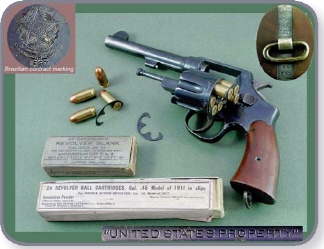
Model 1917, U.S. military. Upper left inset shows marking on Brazilian purchase 1917s. Other insets are details of U.S. military 1917 markings.

PRICE CHECK
U.S. 1917, “virtually mint,” listed at $2000 – David Carroll.
Variations
• Slight premium for early variation with serrated hammer and/or concave grips.
• Target model variation: Very rare. Our information on these is not entirely clear. To the best of our knowledge: Estimated fewer than five produced. Has a round 5-1/2” pinned barrel, with a pinned Patridge front sight (possibly found with a Call Gold Bead) on a raised boss with a rounded rear sight leaf contoured to the frame, adjustable for windage and elevation. The backstrap and forestrap are smooth, the frame also having a lanyard ring. It is thought that these were made for an Army shooting team. This version is also missing the S&W trademark and has all other markings of the standard military model, including a small eagle’s head with an S2 inside the yoke cut, on the barrel flat and the face of the cylinder. Grips may be stamped “U.S.” on both halves. Worth premium. Beware of fakes. We have also received a report of a “Commercial 1917 Target Model” reported as very rare and worth substantial premium. However, it is unclear to us whether this is the same variation discussed above, a different variation, or possibly even a variation of the postwar 1917. Further information would be appreciated.
Price check
Model of 1917 with target sights, serial number 75263, with factory letter showing returned to factory to be fitted with target sights, described as 98+% and extremely rare; reportedly offered in an online forum for $14,500 asking price.
• Commercial variation: Considered rare. A few shipped with nickel finish worth additional premium. A small S&W trademark is stamped on left side of the frame indicating commercial production. May also have a lanyard ring. Commercial shipping box is a one-piece maroon cardboard having a cloth hinge with “S&W .45 DA” inside the lid. Two styles of box are reported. One variation is a maroon two-piece 12” long with a blue end label that reads “U.S. ARMY 45 Model, Blued 5-1/2”, Smith & Wesson, Springfield Mass.” Inside the cover are instructions in English and Spanish. Has a patent date of Dec. 28, 1920. The other is also maroon, about 13” long with no writing at all inside or out.
• Denver Police Dept.: Reported that fewer than 100 commercial 1917s went to the Denver Police in 1932.
PRICE CHECK
Pre-war commercial 1917, in box “near mint…99%”, listed at $2,250, David Carroll, 2006
Commercial Denver P.D. 1917, inscribed to a particular officer, with documents and miscellany, “95%”, listed at $2,500 – Lyle Larkworthy, GunsAmerica.com, 2006.
• Brazilian Contract: 25,000 Model 1917s were made for the Brazilian government and stamped with the Brazilian crest on the sideplate bearing the date “1937.” Although a Brazilian-marked 1917 has been report as early as serial number 16974x, a large 1938 shipment included most guns in serial number range 181983 - 207043, and a 1946 shipment included most guns in serial number range 207196 - 207989. A small S&W trademark is found on the frame’s left side with “Made in USA” on the right side. Supplied with lanyard ring, smooth wood grips and serrated trigger. The hammer has a checked spur. A large quantity were imported in 1990 and usually bear an importer’s mark. Patent dates are found on the top of the barrel with “S&W D.A.45” on the barrel’s left side. These Brazilian-marked 1917s tend to bring about 50 - 75% of what a comparable U.S.-issue 1917 would bring, and average ones can be found in the $350 to $500 range.
• Serial #09 is considered the Frankfort Arsenal Test revolver for the 1906 .45 trials.
• Several known in .45 Colt caliber, worth substantial premium. One example is serial number 180445 shipped Feb. 7, 1929 with nickel finish with 5-1/2" barrel. Later attributed to a Texas Ranger.
• At least one made in 9mm, shipped via BOAC to the UK in 1944 for testing, there fired with British Service 9mm, WRA 9mm, and British .380 ammunition.
• Probably the most infamous Model 1917 revolver was used by John Dillinger in his reign of terror. It is thought to be an original military issue since the frame has evidence of an over-stamp of the Army acceptance marking. It presently resides in the FBI Firearms Lab (Hoover Bld) having all traces of the serial numbers obliterated by Dillinger or his reported gunsmith.
The authors recommend the book by Charles W. Pate titled U.S. Handguns of World War II: The Secondary Pistols and Revolvers for very detailed information about the Model 1917.
Other Pre-War .45 Caliber Hand Ejectors
Other than the Model 1917, pre-war Hand Ejector type revolvers chambered for .45-caliber rounds are sometimes considered to be special chamberings of the .44 Hand Ejector series and may be found in 1st, 2nd, or 3rd Model configurations. See listings earlier in this section. The other possibility for a .45 cal. Pre-war HE is the .455 Mark II HE, 1st or 2nd Model – sometimes as a caliber conversion. The .455 HE listings follow the .45-caliber model listings in this section.
The 1917 Army (Postwar - Transitional)
Caliber: .45 ACP or .45 Auto Rim. Reintroduced May of 1946. Double-action revolver built on the square butt five-screw N frame with 5-1/2” barrel; 1/10” forged round blade front sight, with a square notch rear. Non-shrouded extractor rod, supplied with half moon clips, Magna-style checked diamond walnut grips with S&W monograms, blue commercial finish, .265” checked hammer spur with serrated trigger. Basically a commercial version of the 1917 Army. At the conclusion of WWII 10,000 frames and spare parts stamped in the 1930s were purchased back from the government, assembled and sold as late as 1949 and 1950 again as the Model 1917 Army. Believed that fewer than 1000 commercial versions were made in a serial number range of S209792 - S210782 with an “S” serial prefix to indicate the new postwar hammer block and continued within the 1917 serial number range. One knowledgeable collector reports that these guns are sometimes encountered without the “S” serial number prefix. These commercial versions had the S&W trademark on the sideplate and may or may not have a lanyard ring. Produced c. 1946 - 1950.
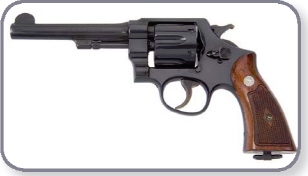
Post-war commercial 1917. Dave Nowak collection, Paul Goodwin photo.

PRICE CHECK
Post-war commercial 1917, “98+%”, listed at $2,000, David Carroll.
The .45 Hand Ejector Model of 1950, Military (a.k.a. 1950 Army)
–“Pre-Model 22”
Caliber: .45 ACP. Introduced November 1951. Double-action revolver built on the square butt N frame with five screws, similar to the 1917 Model with a new shorter throw hammer and trigger with a new slide action hammer block as indicated with an “S” serial prefix. 5-1/2” round barrel. The lanyard ring is discontinued; 6-shot fluted cylinder with a nominal length of 1.53”. Magna-style walnut grips, 1/10” forged round blade front sight with square notch rear sights. 203 were reported chambered in .45 Colt at serial S103000, but only one has been found. This model can be marked “45 CAL MODEL 1950” or “S&W D.A. 45” on the barrel’s right side. Became the Model 22 in 1957. The four standard address lines now appear on the frame’s right side, with a large S&W trademark on the sideplate. Serial number range S85000 - S236000 in the N frame series and possibly as high as S263000. One collector reports a serial number in the S2558xx serial area. 3,976 reported manufactured c. 1951 - 1966.
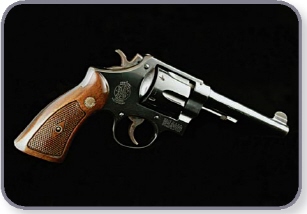
.45 Model 1950 Military. Photo courtesy of Sam Mason.

Variations
• Bright blue finish considered rare, will bring premium.
• Model marked rare, will bring premium. Approximately 178 manufactured with model stamping.
• Reported that around 200 were chambered in .45 Colt c. 1952. At least one has been reported as surfacing. Another source reports a few may exist around serial number S130000 range. Worth substantial premium.
Production Changes
• 1956 Delete upper sideplate screw.
• 1957 Model 1950 .45 Army continued as the Model 22 (see next section, Numbered Model Revolvers).
THE 1950 .45 TARGET MODEL
(Light Barrel) – “Pre-Model 26”
Caliber: .45 ACP (standard) or .45 Colt (scarce). Introduced February 1950. Double-action revolver built on the square butt N Target frame with five screws; 6-1/2” ribbed and pinned barrel, 6-shot fluted cylinder with a nominal length of 1.55” when chambered in .45 ACP, 1.67” when chambered in .45 Colt. Blue finish, Patridge front sight with a micrometer click rear sight, .400” semi-target hammer, .265” grooved trigger standard with .500” target trigger optional. Shrouded extractor rod with uniform diameter. Barrel marked “.45 CAL MODEL 1950.” 200 were chambered in .45 Colt over several years of production. Checked Magna-type diamond walnut stocks or smooth rosewood target stocks on a square butt frame, “S” serial prefix. The .45 ACP version with the tapered barrel became the Model 26. Earliest production may lack caliber marking on the side of barrel. Serial number range S76212 - S211000 with 2,768 reported manufactured c. 1950 - 1961.

PRICE CHECK
Pre-26, “99%”, listed at $1,350 – David Carroll, 2006.
Pre-26, “excellent,” listed at $1,750 – ArmchairGunShow.com, 2005.
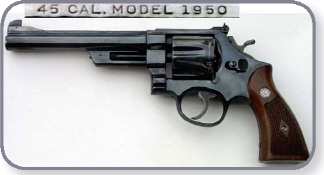
.45 Model 1950 Target. ArmchairGunShow.com photo.
Variations
• Bright blue available on special order, will bring premium.
• .45 Long Colt worth two to four times the standard .45 ACP values.
AUCTION BLOCK
Mod. 1950 Target, .45 Colt, “as new in box…99-100%” - $4,180 – Kull & Supica Auction, April 2006.
• Experimental 6-1/2" heavy barrels supplied to select shooters. Also 4" and 5" barrels have been reported, extremely rare, worth substantial premium if verified.
• At least a couple are reported as original nickel – worth substantial premium if confirmed by factory letter.
Production Changes
• 1953 – 1957: 200 chambered for .45 Colt.
• 1956: Delete upper sideplate screw.
• 1957: 1950 Model .45 Target Light Barrel continued as the Model 26 (see next section).
The 1955 .45 Target Model
(Heavy Barrel) - “Pre-Model 25”
Caliber: .45 ACP. Introduced March of 1955. Double-action revolver built on the square butt N target frame with five screws and a 6-1/2” pinned barrel. Heavy barrel version of the 1950 Target Model, with .500” target hammer and .500” target trigger, target stocks, shrouded barrel marked “45 CAL. MODEL 1955.” Supplied with half moon clips. Patridge front sight with micrometer click rear sight, “S” serial prefix; designated the Model 25 in 1957. Serial number range is S143XXX - S333454, and continued with the “N” serial prefix in 1969. Approximately 1000 units had barrels marked “.45 Caliber Model of 1950” c. 1976. Produced c. 1955 - 1992.
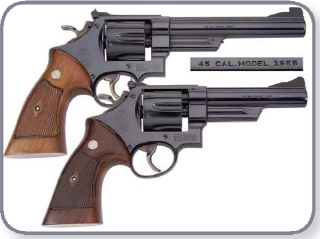
.45 Model 1955 Target; bottom gun has rare 5” barrel. from Paul Goodwin photos.

Variations
• Sometimes found with a “W” or “U” shaped mainspring. Interesting variation, may bring a slight premium.
• Reported that around 15 were made in .45 Colt; we’re aware of one that has surfaced. Perhaps five times standard value.
Production Changes
• 1955: Introduction at approximate serial number S150000.
• 1956: Delete upper sideplate screw.
• 1957–1955: Model Target Heavy Barrel continued as the Model 25 (see next section).
.455 CALIBER
.455 Mark II Hand Ejector 1st Model
(British .455 Mark II Caliber)
Caliber: .455 Mark II cartridge. Introduced September of 1914. Double-action Triple-lock pattern revolver built on the square butt N frame with five screws having a 6-1/2” round pinned barrel, blue finish, square butt checkered walnut stocks. Fixed sights consist of a 1/10” forged round blade front sight; rear sight is a notched cut in the rear of the topstrap. Shrouded extractor rod, smooth trigger and checked hammer spur with color case hardening; 6-shot fluted cylinder with a nominal length of 1.58”. Lanyard ring or butt swivel. This model was designed identical to the .44 Hand Ejector First Model frames (Triple-lock) with a .45-caliber barrel; few will have any caliber stamping on the barrel, more typically the company name and patent dates. Many were converted to .45 Colt as war surplus; these conversions usually are identified by frames having British proof markings, caliber overstampings and machine marks on the face of the cylinder to allow for cartridge spacing. Many have been refinished, but modified revolvers may also have the face of the cylinder left “in the white.” The remainder of production is thought to be military.
The serial numbering of this model can be confusing due to production of similar revolvers in the .44 Hand Ejector 1st Model serial number production range. Note that at least 660 .44 HE 1st Models were converted to .455 caliber for shipment to England and that there is some overlap of serial numbers with the .455 Mk II HE 1st Model serial number range. Refer to Jinks, and Neal & Jinks, for details. Serial number range 1 - possibly c. 6,000 with all reported manufactured c. 1914 - 1915.

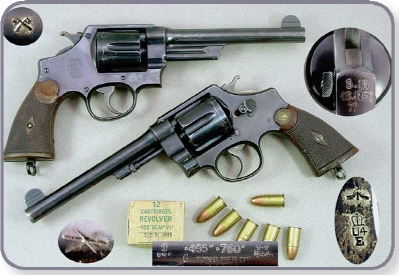
.455 Hand Ejectors: 1st Model (Triple-lock) top, 2nd Model bottom. Insets show typical military markings including Canadian crossed penants, British military broad arrow, and point to point deaccession broad arrows. ArmchairGunShow.com photo.
Variations
• Commercial model worth premium.
• British Target version: A knowledgeable collector reports that a few .455 HE 1st Models were made in a pattern for Bisley range target competition with a drift-adjustable rear sight and 6-1/2” or 7-1/2” barrels, usually found in the 41XX or 43XX serial number range. It is unclear to the authors whether these should be considered as from the .455 Mk II HE 1st Model production or from the .44 HE 1st Model production.
.455 Mark II Hand Ejector 2nd Model
Caliber: .455 Mark II. Introduced 1915. Double-action revolver built on the square butt N frame with five screws and a 6-1/2” round pinned barrel; 6-shot fluted cylinder with a nominal length of 1.58” but being just slightly shorter than the 1st model to correct a condition of cartridge cases being too close to the recoil plate. Similar to the First Model except without the extractor shroud. Inside frame dimensions were also slightly increased. Caliber marking of “Smith & Wesson .455” may be observed on the barrel; other observed barrel markings are “Smith & Wesson Springfield Mass. USA.” “Patented Oct. 8, 1901. Dec. 17, 1901. Feb. 6, 1906.” The extractor rod was also changed. Forged round blade front sight with notch cut rear sight. Smooth .265” trigger with a .265” hammer with case colors. The grips are checked diamond walnut with a gold S&W medallion. This model has a butt swivel for a lanyard cord. As with the first model, many were converted to .45 Colt caliber by S&W or other gunsmiths, with the new caliber being stamped over the .455 markings. An obvious telltale mark is the absence of the serial number on the face of the cylinder and a thinner star extractor where the cylinder was cut down. Many were also converted to .45 Auto Rim. Most observed examples have extensive British proof markings and the stamping “NOT ENGLISH MADE” in very small letters. A large S&W trademark is found on the sideplate. Approximately 691 1st Model frames were assembled and stamped in the 2nd Model serial range. From both Models, 59,150 were manufactured for English service and 14,500 for the Canadian service. A few commercial guns were made, with 13 known in the late 13000 - early 16000 serial number range. Serial number range probably begins between 5000 and 6000, continuing the range of the .455 Mk II 1st Model, to 74755 with 69,754 manufactured c. 1915 - 1917.

Variations
• 724 reported manufactured in .45 Colt for Canadian government.
• Approximately 666 were manufactured in .455 caliber in the 1908 serial range and are duplicates in the serial range 1104 - 10417.
• Often found with unit markings or specific individual names inscribed that may be historically interesting and increase value in accordance with the associated history. For example, serial number 21232 attributed to Major Jeffery Bull (Canadian WWI hero).